Who is Khan Noonien Singh from Star Trek?
Star Trek is a 60-year saga known for its gorgeous starships and equally gorgeous heroes but Khan Noonien Singh is the series' most important villain.
The galaxy far, far away has Darth Vader, the Emperor, Grand Admiral Thrawn and a host of other iconic baddies. Yet, Star Trek and the galaxy right, right here isn't as focused on individual villains that way. However, if the universe created by Gene Roddenberry has a single, identifiable villain it's a 20th Century human who found himself in the future. Khan Noonien Singh is an important villain in Star Trek , and those who don't already know his story are in for an incredible adventure. The character has a long history in the nearly 60-year-old saga, and he remains important to its past and future.
Originally appearing in the Star Trek: The Original Series Season 1 episode, "Space Seed," the character was conceived as a Viking-style character. Roddenberry, however, wanted to subvert the audience expectations of the 1960s by changing that background. The character was named Khan Noonien Singh, in part because Roddenberry hoped a similarly-named acquaintance from World War II would see it and seek him out. (Alas, he never did.) The character was conceived as an actor of West Asian heritage, but the only actor they could convincingly cast to play the futuristic super man was Ricardo Montalban. In 2013's Star Trek Into Darkness, Benedict Cumberbatch was cast to play Khan Noonien Singh, despite him looking more "Viking" than West Asian. While "Space Seed" is an iconic Star Trek: TOS episode, it wasn't until his return in 1982's Star Trek II: The Wrath of Khan written and directed by Nicholas Meyer. Not only did this revitalize the character, but the film reenergized the entire Star Trek franchise after The Motion Picture failed to spark joy in the hearts of Trekkers.
RELATED: This Star Trek: TOS Character Would Fit Perfectly In Strange New Worlds

Who Is Khan Noonien Singh In the Star Trek Canon?
The "Space Seed" episode revealed two things about the Star Trek universe. It revealed the "Eugenics Wars," which involved Khan Noonien Singh. Khan, among others, were genetically engineered to be "perfect" humans. The episode also revealed that as a result of these wars the "records" of that time were mostly lost to Starfleet. Still, Spock told Captain Kirk Kahn ascended into power in 1992 and was defeated in 1996 (30 years from the show's real-world present-day). Khan and 96 of his fellow genetic augments were put into a kind of stasis and sent off into space, where they drifted until the USS Enterprise found the vessel and awakened them. A historian on the Enterprise, Marla McGivers, was charmed by Khan and, almost, helped him take over the ship. Once Kirk and company retook the vessel, he allowed Khan, McGivers and his people to settle on Ceti Alpha V to build a new life for themselves.
In the beginning of The Wrath of Khan , Pavel Chekov (a character not added to The Original Series until Season 2) landed on what they believed was Ceti Alpha VI. They soon found Khan and what remained of his people, because the planet had "shifted" its orbit after a cataclysm. Kahn captured Chekov's ship, the USS Reliant, and used it to take possession of the Genesis Device. Created by Kirk's former partner Carol Marcus and Kirk's son David, it could take a lifeless world and make it teeming with life in hours. Khan wanted to use it as a weapon, but he also wanted to visit vengeance on Kirk. At the end of the film, he's defeated and famously quotes Moby Dick before he uses the Genesis Device to destroy his own ship. "From Hell's heart I stab at thee," he says, "for hate's sake, I spit my last breath at thee."
In Strange New Worlds Season 2, Khan's descendant, La'an Noonien Singh , was sent back in time to the early 21st Century to stop a cataclysm. In Star Trek: Voyager , the crew was sent back to 1996, but instead of a Eugenics War-ravaged landscape, they found the dawn of the internet age. This was established as the "fault" of another time-travel accident. When La'an arrived in her past, she encountered Sera, a Romulan agent from the "Temporal Wars." She was sent back to 1992 to kill Khan in order to prevent the Federation and Starfleet from ever existing. Yet, because of the other time-shenanigans, Khan wasn't born until the 21st Century. "Time pushes back," she told La'an, implying that "canon events" aren't just limited to the Spider-Verse.
RELATED: Kevin Feige's Secret Ingredient in the MCU Came From Star Trek's 'Worst' Movie
Why Khan Noonien Singh Is So Important to Star Trek Fans and Storytellers
Khan Noonien Singh remains important to the larger Star Trek story because of what he represents about the universe's past. The Eugenics Wars, now set in the mid-21st Century also coincided with "World War III," the cataclysm from which Star Trek 's ideal future emerged. In Star Trek: First Contact , the crew of the USS Enterprise-E are sent back to ensure that Zefram Cochrane makes the first warp-drive flight, causing the Vulcans to visit Earth. Khan represents the personification of the worst of humanity. Notions of superiority, violence and authoritarianism are the main impediments, Roddenberry believed, to the idyllic future humanity was capable of achieving.
His many returns, from "Space Seed" in Star Trek: The Original Series to The Wrath of Khan are a warning that these human foibles, like Star Wars ' Palpatine , will somehow return if people aren't careful. Yet, Khan didn't just help create the universe in the narrative. After The Motion Picture , fans hoped for a return to the type of storytelling Star Trek: TOS was known for. Nicholas Meyer delivered a film that felt a bit like an episode of the show on a grander scale. Yet, it also kicked off a run of four more movies that helped cement Star Trek as an enduring franchise. Fans were enamored by the film and its sequels. Even when he's not present, he influences the story. Star Trek: Picard Season 3 thematically echoed the "trilogy" that started with The Wrath of Khan through Star Trek IV: The Voyage Home .
Khan is a genetically altered super man who was so cruel, violent and despotic he almost destroyed the planet. Yet, like most real-world villains, the actual Khan was charming, seemingly measured. Ricardo Montalban infused the character with gravitas and even humor, along with his impressive bare chest (which was not a prosthetic in the movie). If the heroes of Star Trek represent the best of humanity, Khan represents the worst of it. Heroes are defined by their villains, and any hero that can take out a guy like Khan Noonien Singh is an impressive one indeed.
- International edition
- Australia edition
- Europe edition
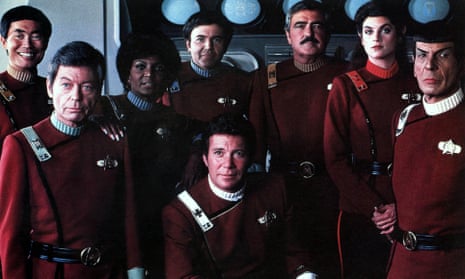
‘KHAAAAN!’: why Wrath of Khan remains the greatest Star Trek movie, 40 years on
A gloriously evil villain, big-screen shocks, mind-control space slugs! The film photon torpedoed everything that went before, leaving a legacy that has yet to be bettered
W hen JJ Abrams began rebooting Star Trek with a fresh cast and crew of the Enterprise in 2009, many hardcore Trekkers complained that the new movies lacked the Apollo-era optimism and vision of space adventure as one giant cosmic morality tale that, in their view, had made the long-running saga stand out from its peers. Gone were slow-paced allegories playing on contemporary western culture, its triumphs and its horrors. In were hectic space battles, time travel, a strange obsession with motorbikes and plenty of fisticuffs.
What many of these critics failed to notice, was that this dichotomy between Star Trek as blockbuster space opera and thinking-man’s sci-fi had been going on for at least three decades before Abrams even got his hand on the Enterprise’s tiller. And to this day, the series’ greatest movie, Star Trek II: The Wrath of Khan, only succeeded because it broke all the rules expected from an episode of Gene Roddenberry’s creation.

The Nicholas Meyer-directed 1982 film, which celebrates 40 years since its UK release this year, was a low budget follow-up to 1979’s Star Trek: The Motion Picture. That film lifted a storyline straight out of the 1960s original series: something about a nefarious energy cloud later revealed as an ancient human space probe refitted by aliens that has subsequently achieved sentience and turned on Earth. The plot was so nebulous that even Spock struggled to work out what was going on. It duly picked up middling reviews and was a box-office disappointment for studio Paramount, largely due to its gargantuan (for the time) $44m shooting budget.
Out went Roddenberry (as producer) and in came Meyer to write and direct the project, with a much more frugal $12m budget. As well as including some juicy sci-fi stylings such as the Genesis terraforming program, Meyer, who knew nothing about Star Trek, spotted early on that the sequel needed an antagonist for William Shatner’s Admiral James T Kirk to face off against if it was to achieve the right level of big screen theatricality. The perfect solution was to bring back Ricardo Montalbán’s Khan Noonien Singh from the 1967 TV episode Space Seed, about a group of dangerous superhumans encountered by the crew of the Enterprise, who are left stranded by Kirk on an uninhabited but fertile planet.
At the time this is intended to be a merciful decision by the captain, an alternative to being sent to a penal colony for their crimes. But of course, we swiftly find out in Wrath of Khan that the supposedly perfect world picked by Kirk turned out to be in an unstable region of space, and that most of Khan’s people ended up dead or starving when a neighbouring planet subsequently exploded. Oops.
Cue a Melvillian battle between the two men as Khan takes out 15 years of frustration on his nemesis. Montalbán chews scenery like it’s an Ikea showroom made out of prime steak, yet crucially never slips too far into the realms of pantomime. The veteran Mexican actor remains a terrifying, vengeful force of nature, rage personified, throughout.
At the end of each episode of the original series, there was usually the sense that the Enterprise could fully reset, with danger averted and normal duties resumed. By contrast, the events of Wrath of Khan are so horrific that they can never be forgotten, and the level of threat seems to have been suddenly upped to warp factor 9.9.

Walter Koenig’s Chekov, along with newcomer Clark Terrell (captain of the USS Reliant) are mind-controlled by Khan using hideous space slugs that are painfully, and bloodily lodged inside their ears! Spock dies of radiation poisoning trying to restart the Enterprise’s warp engine! Khan himself is left to die once again after being summarily outwitted by his supposed inferiors. Where The Motion Picture was mildly intriguing, Wrath of Khan represents blood-pumping, big screen shock tactics on an epic scale.
Thirty years later, Abrams tried to recapture its magic with an effective remake, Star Trek Into Darkness. But even with Benedict Cumberbatch as a younger version of Khan (who crucially never got marooned by Kirk in the new timeline, so was really just a boring, big-headed eugenics experiment in human form) most of the original’s bloodthirsty lust for life and death failed to re-manifest.
Into Darkness was once voted hardcore fans’ least favourite Star Trek movie , a nadir for anyone who loved the original series’ more intellectual, cosmic musings. Yet it was all based on a movie that had to destroy everything that went before it, everything that fans expected from a Star Trek episode, just to keep the Enterprise from crashing down to earth for ever.
- Week in geek
- Science fiction and fantasy films
- US television
Comments (…)
Most viewed.

SS Botany Bay
- View history
The SS Botany Bay was a DY-100-class sleeper ship built on Earth in the late 20th century . The Botany Bay was launched from Earth in 1996 , under the command of Khan Noonien Singh . The Botany Bay was used by a group of genetically-enhanced Humans known as Augments , led by Khan Noonien Singh, in an attempt to escape from Earth after being defeated by non-Augments.
Khan intended to find a world for himself and his people that they could colonize. Initially, Khan and eighty-four of his followers were placed in cryogenic freeze. Twelve of the suspended animation life support canisters failed while in deep space, leaving Khan himself and seventy-two Augments to survive. ( TOS : " Space Seed "; Star Trek II: The Wrath of Khan )
- 1.1 Prime reality
- 1.2 Alternate reality
- 2 Personnel
- 3.1 Background information
- 3.2 Apocryphal
- 3.3 External links
History [ ]
During the 22nd century , the Botany Bay was believed to be a myth. Arik Soong was among those who doubted the theory of the ship's existence. Malik used it as an example of why the Augments Soong created should not run away. ( ENT : " The Augments ")
Prime reality [ ]
In 2267 , 271 years after its launch, the Botany Bay was discovered by the USS Enterprise in a sector that was infrequently visited by Earth ships. The Botany Bay was rigged for towing by crew from the Enterprise . Traveling at warp factor 2, the Enterprise , with the Botany Bay traveling alongside, entered the adjacent Sector 25712 on a heading toward the sector's command base – Starbase 12 .
Upon revival, Khan and his followers, with the assistance of Lieutenant Marla McGivers , seized control of the Enterprise , and left the now-useless Botany Bay adrift in space. The hijacking was quickly overcome by Captain Kirk and his officers . Kirk offered Khan, his followers, and Marla McGivers the chance to settle the uninhabited world of Ceti Alpha V , an offer which Khan accepted. ( TOS : " Space Seed ")
Various personal effects transferred from the Botany Bay were kept within Starfleet-issue cargo carriers provided by the Enterprise to start the colony. The cargo carriers were subsequently used as shelters by Khan and his followers for almost eighteen years on Ceti Alpha V after the planet became a desert wasteland. Once they escaped Ceti Alpha V on the USS Reliant , the Reliant 's crew took up residence inside it for shelter after Khan marooned them there. Once Admiral Kirk saved the crew aboard the Enterprise, the Botany Bay was abandoned on the planet. ( Star Trek II: The Wrath of Khan )
Alternate reality [ ]
In 2258 of the alternate reality , Section 31 performed secret investigations in unexplored space for means of better defending the Federation after the destruction of Vulcan . They discovered the Botany Bay , 262 years after launch, and Khan was awoken. With the other 72 augments still in stasis under Section 31's control, he was forced to join and work for Starfleet as Commander John Harrison . ( Star Trek Into Darkness )
Personnel [ ]
Eighty-five Augments were placed in cryogenic freeze. Twelve of the suspended animation life support canisters failed leaving thirty female and forty-three male Augments to survive, including Khan , Otto , Joaquin , Kati , Rodriguez , Ling , McPherson , and others . Lieutenant Commander Montgomery Scott described them as a group of mixed types: Western, mid- European , Latin , Oriental . ( TOS : " Space Seed "; Star Trek II: The Wrath of Khan )
- List of SS Botany Bay personnel
Appendices [ ]
Background information [ ].

A Bajoran religious symbol
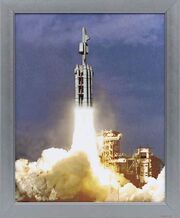
Botany Bay being launched
The Botany Bay was named for the Australian geographical location , the site of the first penal colony on the shores of Australia .
The original model was designed by Matt Jefferies , and most likely built by Film Effects of Hollywood . The model stood 44 inches in length, and was constructed of wood, with no internal lighting. Jefferies also added the weathering seen on the model. Effects shots showing the Botany Bay alongside the Enterprise were filmed at Film Effects. ( Star Trek Magazine issue 120 )
Based on behind-the-scenes photos from The Wrath of Khan , Khan's shelter in the film consisted of Starfleet cargo containers. They were designed based on the cargo containers hauled by workbees in Star Trek: The Motion Picture , complete with an attachment sled. The movie-era Federation seal can also be seen on the exterior of one of the containers and was just barely visible in the film itself. ( citation needed • edit )
In the 2006 "remastered" version of "Space Seed", the Botany Bay appeared adrift on a different axis than the Enterprise in a much more "weathered" state than it did in its original appearance, to match Spock 's line stating that its " hull surface is pitted with meteor scars." The conning tower was also given a very small docking port , added by Michael Okuda at the suggestion of a NASA engineer with the thought that a spacecraft built in the 1990s would have such a port to dock with the International Space Station .
The Bajoran religious wheel symbol (sometimes seen, for example, in Kira 's, Sisko 's, and Dax 's ( DS9 : " Dax ") quarters or Varis Sul 's ( DS9 : " The Storyteller ") and Vash 's guests quarters ( DS9 : " Q-Less ") on Deep Space 9 ) was composed of rotated images of the Botany Bay . A more prominently featured version can be seen in Kai Winn 's quarters during her meditation in " 'Til Death Do Us Part ".
According to the Star Trek Encyclopedia , the Botany Bay was either found near the Mutara sector (4th ed., vol. 1, p. 98) or in the sector itself (4th ed., vol. 2, p. 60).
During the production of Star Trek it was briefly considered putting a shot of the Botany Bay in after the end credits, as an Easter egg . However, it was decided against, as it was felt that this would tie the hands of the production staff for the film's sequel story. ( Star Trek audio commentary
According to the Star Trek Encyclopedia (4th ed., vol. 1, p. 98), " A conjectural model of the Botany Bay , built by Greg Jein for a photograph in the Star Trek Chronology , was equipped with several space shuttle -style solid rocket strap-on boosters, suggesting how the 1996-vintage spacecraft might have gotten into orbit . The model was seen as a desktop decoration in Rain Robinson 's SETI laboratory in the 1996 scenes of " Future's End " and " Future's End, Part II " ( VOY ) and the photograph was used as set dressing on the wall of the 602 Club in " First Flight " ( ENT ). "
The second edition of the Star Trek Chronology featured an image of the Botany Bay being launched from Earth with the use of booster rockets similar to those used by the space shuttle orbiter . The "launch mode" model was built by Greg Jein , while Michael Okuda composited the image, using a NASA photo of a space shuttle launch.
Apocryphal [ ]
According to the novel The Rise and Fall of Khan Noonien Singh, Volume Two , the Botany Bay was launched from Earth on January 11 , 1996 .
In contrast to that, in the comic miniseries Star Trek: Khan , Khan from the alternate reality claims that the Botany Bay launched sometime after May 6 , 1996.
The Starships RPG sourcebook gives the Botany Bay 's registry as DY-109.
External links [ ]
- SS Botany Bay at StarTrek.com
- SS Botany Bay at Memory Beta , the wiki for licensed Star Trek works
- 3 Erigah (episode)
- Show Spoilers
- Night Vision
- Sticky Header
- Highlight Links

Follow TV Tropes
http://tvtropes.org/pmwiki/pmwiki.php/Characters/StarTrekTheOriginalSeriesKhanNoonienSingh
Characters / Star Trek: The Original Series - Khan Noonien Singh
Edit locked, khan noonien singh.
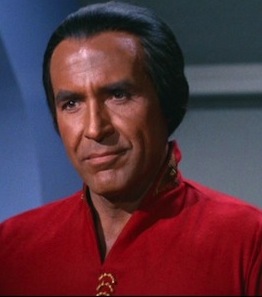
Played by: Ricardo Montalbán , Desmond Sivan (child, Strange New Worlds )
Dubbed in french by: françois chaumette (star trek ii), dubbed in brazilian portuguese by: darcy pedrosa, appearances: star trek: the original series | star trek ii: the wrath of khan | star trek: strange new worlds.
Khan: Khan is my name. Kirk: Khan, nothing else? Khan: Khan.
A 20th-century genetically-engineered tyrant who ruled a quarter of the world in the 1990s. As his fellow "supermen" (or Augments) were overthrown, Khan and roughly 80 of his followers launched themselves into space in cryogenic sleep before being found by Kirk. With his weakness being his ambition, Khan then tried to seize control of the Enterprise with the help of Marla McGivers , the Enterprise ship historian whom he managed to seduce. It failed thanks to the crew's opposition and an attack of conscience from McGivers . Kirk then exiled Khan, his followers, and Marla to a remote but hospitable planet as an act of mercy, giving them the chance to build a new society. Unfortunately, not long afterwards, the planet suffered a catastrophic ecological disaster and, being completely forgotten by Kirk, Khan grew vengeful toward the man who cast judgement on him...
open/close all folders
- A Father to His Men : He saw his fellow super humans as a family, to the point where he vowed to avenge Joachim when he died following a crippling blast on the Reliant .
- Affably Evil : In his first appearance, Khan's pretty charming, polite, and a bit of a rogue, just like Kirk. However, come Wrath of Khan and Khan is just losing it.
- Alas, Poor Villain : At the end of Wrath of Khan , he's lost everything, including his beloved wife as well as his people, along with any hope of being able to establish a society for them. As he's left to die in the exploding Reliant , he remains Defiant to the End , reciting dialogue from Captain Ahab in Moby-Dick before the Reliant explodes. All that potential he had as a superhuman was essentially wasted out of a desire for control and revenge.
- Ambiguously Brown : He's a genetically-augmented human from some point in the late 20th century. Culturally, he's a North Indian Sikh, but as he is also a genetically-engineered human, his DNA could contain many different genetic traits (his Mexican accent, however, is difficult to explain - especially after the effects of various Temporal Wars caused his birth to be bumped a half century later ... and to Canada ).
- Anti-Villain : Cruel and immoral his actions may be, he wants a society that he and his people can thrive in, no matter how many others have to suffer for it.
- Arch-Enemy : More than a hundred years later , Spock would credit him as being "the most dangerous adversary the Enterprise ever faced."
- Ascended Extra : Goes from a random Villain of the Week to the main antagonist of The Wrath of Khan and one of the franchise's most iconic villains.
- A tie-in comic to Star Trek Into Darkness addresses Trek 's Alternate History directly, starting with Khan nuking Washington, D.C. in 1992 .
- The final episode of Star Trek: Picard Season 2 implies and the first episode of Star Trek: Strange New Worlds confirms that under the Alex Kurtzman production umbrella the Eugenics Wars are being moved from the 1990's to the 2030's, with the implication that the 1990's is when the technology to create Khan was developed. This could be explained as Spock getting the dates wrong due to incomplete records, if it weren't for one line from The Wrath of Khan in which Khan himself states he departed Earth in 1996.
- The third episode of Season 2 of Star Trek: Strange New Worlds untangles the thread by revealing that Khan is responsible for bringing humanity to a dark age, which ultimately brings humanity to eventually form the Federation and Starfleet. Khan himself is the target of a temporal war to prevent this from occuring, which only succeeds in delaying his rise from the 1990's to the 2030's. His failure to rise culminates in humanity failing to progress beyond their own Solar System, having failed to ally with other species such as the Vulcans who are eventually wiped out in a war with the Romulans.
- Bread and Circuses : His ruling style back when he was a dictator over a fourth of Earth, at least compared to his competitors, which was enough to give him a legacy as "the best of tyrants." Notably, there were no massacres under his rule, and he didn't involve himself in the Eugenics Wars until after his territory was attacked. On the other hand, the people under his rule were reduced to subjects with few freedoms.
- Breakout Villain : Originally just a Villain of the Week . Ever since Wrath of Khan , he's arguably the most highly-regarded villain in the entire franchise.
- Character Catchphrase : He has a particular way of saying "Admiral" he develops once he learns Kirk has gotten a promotion. At least one interpretation is Khan thinking Kirk got that for dumping him on Ceti Alpha V (because why wouldn't it be about Khan?), and raging jealousy that that's what he got while Khan got the shaft.
- Classic Villain : Khan represents a nice combo of Pride and Wrath .
- Control Freak : Khan demands absolute obedience from everything. While some of his followers can object, none of them will sway him from his course.
- Damned by Faint Praise : He is seen as "the best of tyrants" in regards to the Eugenic Wars.
- Dramatically Missing the Point : A fan of Moby-Dick , Khan sees himself as Captain Ahab and Kirk as his White Whale. Khan seemed to have forgotten how Ahab's quest for vengeance ended. Not just self destruction - he understands and accepts that - but that Ahab didn't even get a chance to make sure he succeeded.
- The Dreaded : Even a century after his death, Starfleet is still terrified of him. It's outright said that the main reason the Federation still has a No Transhumanism Allowed policy in the Star Trek: Prodigy era is because they're scared of a new Khan rising from the ashes. His reputation even extends into a new timeline: When young Spock asks for information about Khan, Spock breaks his own oath not to tell him about the future to warn him about how dangerous Khan is, outright saying that he's the most dangerous enemy the Enterprise ever faced.
- Even Evil Has Loved Ones : While he started manipulating Marla McGivers to betray Starfleet as a tool to escape, he came to passionately love her after she joined him in exile. He forgave her betrayal of him to her old crew, and she ruled as his queen. Her death on Ceti Alpha V - more than that of his other loyal followers - is what drives the man who once conquered a quarter of Earth.
- Evil Overlord : Back in the day, anyway. He tries to give it another go in "Space Seed" but is thwarted and offered the opportunity of becoming one to an abandoned planet. But when the planet unexpectedly suffers a catastrophe that devastates him and his followers , he settles on a simpler motive.
- Joachim begs Khan to ignore Kirk and exploit Genesis. Khan shoves him aside and orders the Reliant to follow the Enterprise into the Nebula.
- Faux Affably Evil : Becomes one in The Wrath Of Khan , blinded by his desire to get revenge on Kirk. That doesn't undermine his intelligence, though.
- Genius Bruiser : A Superhuman with immensely powerful physical and mental capabilities.
- Glass Cannon : Has the physical strength to bend a phaser in half with his bare hands and effortlessly lift a spacesuit-wearing Chekov with one arm, but gets taken down by Kirk with a pipe.
- Greater-Scope Villain : Arguably his interactions with the Enterprise are much smaller in significance compared to how much his role as a 20th Century Dictator defines and causes the creation of the Federation.
- Heinousness Retcon : In Space Seed , and to a lesser extent Wrath of Khan , Khan is introduced as a 20th century dictator, but otherwise fairly little is made of him. It's in fact noted that he's only one of several dictators active at the time - if the strongest of them. He's otherwise unremarkable and obscure enough that unraveling his identity is a huge chunk of the episode, and the crew need a briefing to explain who the man was. Scotty, and later Kirk even confesses having a degree of admiration for the man. Bones even mentions in slight defense of Khan that "there were no massacres" in his rule, though Spock immediately states, "and little freedoms." Later series would characterize Khan as basically Trek's version of Hitler ( with Captain Picard alluding to both of them in the same breath ). A man whose name is a byword for evil and death, and whose actions are so despicable, the Federation centuries later is still sort of processing the trauma of them, and has laws on the books to stop a man like him from ever being made. Star Trek: Strange New Worlds even had admirals admit that these laws are draconian and discriminatory but humans are still so sensitive about what Khan did that repealing them is unthinkable.
- Hero Killer : He was directly responsible for Spock's death in the second movie. Hard to fit the trope more plainly when you've done that .
- Hitler's Time Travel Exemption Act : His descendant La'an Noonien-Singh has to save his life as a child in 2022, not just so she will be born but also as Romulans had sent an agent back in time to kill him. It turns out that without the Eugenics Wars to make humanity want to be better, whilst humanity will still reach space they will become the isolationist United Earth Fleet an easier smaller target amongst many rather than the alliance that is the Federation.
- In Love with the Mark : He started off manipulating Marla, but quickly came to genuinely love her.
- Karma Houdini : He was this In-Universe for his crimes during the Eugenics Wars. While all the other superhumans were implied to have been killed or imprisoned, Khan managed to escape on the Botany Bay . Even when he's later released by the Enterprise crew, there's no serious talk of putting him on trial and he's eventually given a whole planet of his own to rule. Then Ceti Alpha VI exploded , depriving Khan of his beloved wife and sentencing him to a hellish existence on a Death World .
- Morality Pet : His possible son Joachim, who he genuinely loves and cares about.
- Motive Decay : Initially, all he wants is to create a society where he and his people can thrive, but by the time of The Wrath of Khan , all he wants is revenge against Kirk.
- Mr. Fanservice : He's almost always wearing an outfit that displays his muscular chest and great physique.
- My God, What Have I Done? : Khan's final moments include one of these with the death of Joachim, who may very possibly be his biological son and almost certainly is his adopted son. Realizing he got him killed doesn't deter him from further actions, though.
- Navel-Deep Neckline : A Rare Male Example , his pecs are well displayed.
- No Shirt, Long Jacket : In the movie (though the jacket is quite damaged), to show off Montalban's great shape.
- No Transhumanism Allowed : In Star Trek: Deep Space Nine , it's explained that Khan is the reason the Federation prohibits genetic modification or engineering.
- Photographic Memory : Implied to be one of his genetically engineered gifts, and stated explicitly in the novelization of Wrath of Khan and the expanded universe's "Khan trilogy". He tells Chekov he never forgets a face, and even after 15 years he still seems to have the Enterprise 's technical specifications committed to memory, given that he still has perfect knowledge of the ship's weak points.
- Pride : He has oodles of it.
- Reasonable Authority Figure : At least to his fellow superhumans. His interactions with Joachim in Wrath of Khan show that his followers are comfortable enough with him to give him critical feedback without any hesitancy, although in the end his own authority is absolute.
- Vaguely justified in that Khan and Singh are both overwhelmingly common Indian names, however.
- Revenge Before Reason : He will do anything to kill Kirk, no matter how self-destructive. Even when Kirk is clearly baiting him into an obvious trap, Khan seems physically incapable of resisting the urge to roar into it, so fervent is his hatred. Khan: No... you won't get away. From Hell's heart, I stab at thee. For hate's sake, I spit my last breath at thee...
- Revenge Myopia : Khan ignores Chekov's observation that he attacked Kirk after the latter had taken in him and his crew.
- Rule of Symbolism : Much of the conflict between Kirk and Khan plays out like Paradise Lost , with Kirk as God and Khan as Lucifer . Khan even lampshades this in "Space Seed." In The Wrath of Khan , he has two copies of Paradise Lost on his bookshelf (one which included Paradise Regained ).
- Sanity Slippage : By the time of The Wrath of Khan , he’s lost it thanks to being stranded on Ceti Alpha V and the death of his wife and most of his followers.
- Sealed Evil in a Can : He and his cryogenically-frozen followers, in the episode " Space Seed ." And again in Star Trek II: The Wrath of Khan , when he's abandoned on Ceti Alpha V (which the crew of the Reliant mistake for Ceti Alpha VI after a natural disaster alters its orbit and destroys its environment).
- Sequel Adaptation Iconic Villain : Star Trek: The Motion Picture had the crew of the Enterprise confront V'ger as the antagonist. Wrath of Khan brought Khan back and more dangerous than ever.
- Silver Fox : For a man who was stranded on a nightmare planet for two decades, Khan still managed to age pretty damn well, and he clearly knows it. Check out them pecs, for one.
- Skilled, but Naive : Other than his pride and ambition, one of Khan's greatest weaknesses is that, despite his incredible intellect, all his knowledge and experience is that of a 20th century man, and he lacks the decades of experience in space that Kirk has. This shows when he's unable to quickly find the Reliant 's command console override despite having memorized Starfleet's standard starship technical specifications, and when he fails to consider that space is three-dimensional during starship combat. Spock: He's intelligent, but not experienced. His pattern indicates two-dimensional thinking.
- Soft-Spoken Sadist : In Wrath , at least regarding Kirk and all collateral damage. Khan: I've done far worse than kill you. I've hurt you... and I wish to go on hurting you.
- Stalker with a Crush : Meyer confirmed that the Foe Romance Subtext between Khan and Kirk was intentional, and Khan twists Moby Dick lines to “he tasks me, he tasks me and I shall have him.”
- Star-Crossed Lovers : He and his wife, a crewman on the Enterprise who suffered from Heel–Face Revolving Door Syndrome.
- Suddenly Shouting : "This is Ceti Alpha Five!!
- Why Khan wants Project Genesis. With his homeworld destroyed and his people dwindling in numbers, he feels that terraforming a planet is the only way to ensure his and his people's continued existence.
- In "Space Seed", Khan makes it clear he believes that he would have been the eventual victor of the Eugenics Wars if things had gone differently (" One man would have ruled eventually. As Rome under Caesar, think of its accomplishments!")
- The Bad Guy Wins : Yes, Khan is killed by the end of The Wrath of Khan , but what happens after that? Spock — Kirk's closest friend — dies painfully as a result of radiation poisoning in his efforts to repair Enterprise enough to escape the Genesis Device detonation . Then as a result of his quest to bring his friend back from the dead , Kirk loses not only his beloved Enterprise but also his son. Ultimately, Khan has done far worse to Kirk than kill him — he hurt him.
- Took a Level in Jerkass : Khan becomes far more ruthless and unhinged in The Wrath of Khan , thanks to his Sanity Slippage and single-minded vendetta against Kirk.
- Tragic Keepsake : Khan wears a Starfleet emblem on a chain around his neck, strongly implied to have been part of Marla McGiver's uniform. note It's also a continuity problem: The insignia is similar to the belt buckle worn as part of the movie uniforms, however was not actually present on the uniform McGivers would have worn.
- Tragic Villain : Subverted. Khan has all the hallmarks of a tragic character, having suffered a great loss that drives him to committing evil, but while he is sympathetic, he was a ruthless dictator even before this. The only thing it really changed was how evil he was, causing him to go from Affably Evil to a spiteful, unhinged demagogue.
- Trouble from the Past : He perfectly embodies both the modern age's charismatic daring and its prideful ambition, transported through time almost 300 years to menace the utopian future of the 23rd century, which he comes to believe is ill-prepared to resist himself and his crew of supermen. Kirk ultimately proves him wrong on that account.
- Ungrateful Bastard : Kirk and company find a stasis ship just in the nick of time, as Khan's own capsule is about to fail, revive him and his followers, and treat him with frankly undue courtesy given who he is— so Khan decides to steal his ship. Then Khan resents Kirk leaving him and his people on Ceti Alpha V, even though that was more lenient than taking him back to Earth, where he would have been prosecuted as a war criminal.
- Justifies his quest to Take Over the World as an attempt to unify humanity during a time of war.
- Subverted by the movie, in which it becomes abundantly clear he isn't as interested in conquering as he is in killing one man over a grudge.
- Wicked Cultured : His Final Speech comes from Moby-Dick , he mentions Paradise Lost before Kirk exiles him, and the Botany Bay appears to have other classic books. Part of his obsession with Moby-Dick in particular seems to be because Khan was stuck on Ceti Alpha V with only a handful of books to read, leading him to read them over and over again.
- Young Conqueror : Both Expanded Universe versions of his Origin Story (the 2001 novels by Greg Cox and the 2014 comic book tying in to Star Trek Into Darkness ) place him as being either in his early or late 20's during the Eugenics Wars. The novels indicate that faster-than-normal maturation is part of his genetic modifications.
Commander John Harrison/Khan Noonien Singh (Kelvin Timeline)

Played by: Benedict Cumberbatch
Dubbed in french by: pierre tissot, dubbed in brazilian portuguese by: ronaldo júlio, appearances: star trek into darkness.
Starfleet's top agent, before a perceived betrayal by his superiors sent him on a Roaring Rampage of Revenge against the entire Federation command structure.
- The Ace : As Harrison himself claims, he is simply "better" at everything . Justified, as he is genetically designed to be so.
- Adaptational Jerkass : The original Khan was in no way a nice person, but he was Affably Evil , at least in "Space Seed", and had an entertainingly hammy persona. This one is far more cold blooded and stoic.
- Adaptational Villainy : As seen above, in Space Seed Khan had committed no massacres in his reign. Here Spock accuses him of planning to commit mass genocide on any being he deems "less than superior".
- Aesop Amnesia : Openly vows to resume "the work" he and his crew had done prior to banishment. Despite having failed in his despotism in the Eugenics Wars, he still hopes to start right over.
- He also has a spinoff comic. See Villain Episode .
- Alternate History : The Villain Episode tie-in comics tackle the Failed Future Forecast issues around the Eugenics Wars head on... by showing Khan nuking Washington D.C. and Moscow... in 1992 .
- The Antichrist : He's not supernatural, of course, but the tie-in comics use a fair share of "The Beast of Revelations" imagery when describing his rise to power during the Eugenics Wars.
- Arch-Enemy : For Kirk, much like Nero for Spock in the last film . And well, himself for Kirk in Star Trek II: The Wrath of Khan .
- Boasts about his superhuman abilities. Harrison: I am better. Kirk: At what? Harrison: Everything. note In the novelization , the tone of voice he says this with isn't that of a boast, but a simple statement of fact by a man who knows that it's true.
- Boasts about how he's going to end you. Harrison: I will walk over your cold corpses.
- Badass Longcoat : Sports a black trenchcoat with a hood. He even steals one off a chair towards the end of the film to replace it. Presumably, this was to help disguise him to some extent.
- Benevolent Boss : Zig-zagged between this and Bad Boss . While he does seem to truly care for his crew, he was also a ruthless tyrant and war criminal 300 years prior. Harrison: My crew is my family, Kirk. Is there anything you would not do for your family?
- Berserk Button : Threatening his crew or implying that they're dead is a seriously bad idea. Admiral Marcus found that one out the hard way.
- Big Bad : A Starfleet agent with superhuman abilities turned terrorist. He's really Khan Noonien Singh, an infamous war criminal working for Starfleet under an assumed identity.
- Big Bad Ensemble : Serves as Into Darkness 's main antagonist, alongside Admiral Marcus . Towards the climax, however, Khan kills Marcus , establishing himself as the sole Big Bad .
- Big "NO!" : He yells "No" when he thinks that his crew has been killed after the torpedoes explode on his ship.
- Bio-Augmentation : Genetically engineered for superhuman strength, endurance and intelligence.
- Bullying a Dragon : Nice job trying to force a 300-year-old superman stronger, smarter and more ruthless than you to do your dirty work by threatening to kill his crew (which is essentially his family), Marcus .
- Byronic Hero : A Villainous example. He fits the bill in a few ways: Brooding, charismatic, sympathetic and physically attractive but also incredibly vengeful, prideful and was once an Evil Overlord back in the day.
- Canon Character All Along : This is one of Into Darkness 's main twists. John Harrison is revealed to be none other than Kirk's Arch-Enemy Khan Noonien Singh.
- Canon Foreigner : Subverted. He's actually Khan Noonien Singh.
- The Chessmaster : Most of the events of Into Darkness are the result of Harrison's planning and manipulations.
- Chewing the Scenery : While there is some mugging during "annoyed/angry exposition" , when he gets furious, Evil Is Hammy gets into full force. You should have let me SLEEP!
- Commanding Coolness : Harrison's falsified rank in Starfleet was Commander.
- Cool Starship : The USS Vengeance , a jet black Federation dreadnought that Harrison helped design and later steals after killing Admiral Marcus .
- Creepy Monotone : Making him even more scary. And a complete inversion of Ricardo Montalban's hammy original. Benedict Cumberbatch 's performance just drives the whole thing home since you really can't watch him like this without shuddering at least once.
- Dark Is Evil : Dresses exclusively in black clothing. Benedict Cumberbatch also dyed his hair black for this film again. Also, the Vengeance , a pitch-black monster of a warship, was his design, and he takes command of it near the climax of the film.
- After Kirk's utterly ineffective beatdown on Kronos, Harrison contemptuously repeats Uhura's invocation of Kirk's rank. Harrison : Captain .
- During his conversation with Spock after Harrison hijacks control of the Vengeance . Spock : You betrayed us . Harrison : Oh, you are smart , Mr. Spock.
- Death Seeker : When he thinks his crew is dead, Khan has shades of this when he attempts to ram The Vengeance into Starfleet Headquarters. Harrison : SET DESTINATION: STARFLEET HEADQUARTERS! Vengeance's computer system : Engines compromised. Cannot guarantee destination. Confirm order. Harrison : Confirm.
- Despair Event Horizon : He crosses it when he believes his beloved crew to have been killed. After that, Khan stops caring if he lives or dies, setting the Vengeance on a suicide run to Starfleet Headquarters.
- Do Not Taunt Cthulhu : As he notes, Starfleet really should have kept him asleep .
- Dragon-in-Chief : Marcus forced him to help design the USS Vengeance for Starfleet but he is a much more direct threat to the heroes than the Admiral and only serves him to save his crew, and Harrison shows himself to be the more competent villain when he kills Marcus to commandeer the Vengeance .
- The Dreaded : Spock Prime's encounters with Harrison/Khan's prime universe counterpart are enough to convince him to give Spock information about him, despite his previous pledge to let Spock walk his own path.
- Driven to Villainy : Subverted. While his present motivations are to get back at Starfleet for Admiral Marcus for holding his family hostage, Khan was a war criminal before being frozen, and was specifically defrosted for both his intellect and his willingness to use it aggressively .
- Eerie Pale-Skinned Brunette : He has dark hair, retains his actor's pale complexion and serves as a contrast to Kirk and Admiral Marcus .
- Emperor Scientist : In the tie-in comics it's indicated that this was his ruling style after he accomplished his initial conquests.
- Empowered Badass Normal : Being a bio-engineered super-human, he's a Nigh-Invulnerable One-Man Army Evil Brit in a Badass Longcoat . Not even an extremely angry Vulcan on a Roaring Rampage of Revenge was enough to stop him without help.
- Even Evil Has Loved Ones : Wants to save his former crew who were on board the SS Botany Bay . Harrison: Is there anything you would not do for your family?
- Evil Brit : Retains the accent of his actor, the British Benedict Cumberbatch .
- Evil Cannot Comprehend Good : His terrorist attacks are motivated by his suspicions that Starfleet has already killed his crew, mainly because that's exactly what he would have done in their place. Later, after the torpedo incident, he again assumes that his enemies have killed off his crew and decides to make the Vengeance 's name very literal. One gets the impression that Khan just can't wrap his head around other people not being as murderous and willing to kill for convenience as him.
- While Harrison/Khan displays similar mannerisms to that of Spock in his initial appearance, the differences in their character increasingly become apparent following The Reveal . Khan actually goes so far as to distinguish himself from Spock by pointing out that he indulges and takes pride in his savagery while Spock suppresses such emotions. Harrison: Intellect alone is useless in a fight, Mr. Spock. You, you can't even break a rule. How could you be expected to break bone ?
- Evil Is Hammy : Even when he's not raising his voice, he is full of Cold Ham with the way he overenunciates his words.
- Evil Is Not a Toy : Starfleet really shouldn't have tried to manipulate or threaten him.
- Evil Is Petty : Being shunned after helping Marcus with his warmongering plans is as bad for him as the fact the admiral kept his "family" hostage.
- Evil Overlord : Ruled over a quarter of Earth centuries ago.
- Evil Sounds Deep : Benedict Cumberbatch plays the character with a deep baritone voice.
- Fantastic Racism : He finds being at the beck and call of the genetically "inferior" humiliating.
- Face–Heel Turn : He went from a decorated member of Starfleet to a terrorist trying to destroy it. Only not; the John Harrison identity was created for him when he was thawed, and the closest he came to working for Starfleet was his unwilling stint making weapons for Admiral Marcus.
- Fallen Hero : Subverted. He was a bad guy long before his falsified past.
- Fatal Flaw : Pride . While his original timeline version was more defined by the It's Personal nature of Wrath pushing him to obsessively pursue Kirk in Revenge Before Reason , here, his condescending contempt for Kirk’s crew manifests as arrogance bordering on blindness— in particular, he seems incapable of conceiving that Spock could have the cunning to match him even briefly, or meet Khan’s savagery with his own. The first costs him his ship, and the second leads to a brutal fist fight with the half-Vulcan that is more than even Khan could have predicted.
- A Father to His Men : He genuinely cares about his crew and will do anything to protect them. Harrison : My crew is my family, Kirk. Is there anything you would not do for your family?
- Faux Affably Evil : Though Harrison genuinely cares for his crew, the politeness he demonstrates towards Kirk and others is relatively fake. Once his nominal allies have outlived their usefulness , he'll have no hesitation about killing them.
- First-Name Basis : Upon the revelation of his true identity, he's addressed solely as "Khan". Only Spock Prime even mentions the rest of his name.
- Genetic Engineering Is the New Nuke : Harrison is a One-Man Army created through genetic manipulation. It turns out to be the first hint of his true identity.
- Genius Bruiser : He's incredibly intelligent ( within a year, he learned enough about 23rd century technology to design advanced weaponry, as well as the nigh-unstoppable USS Vengeance ) and extremely strong (enough so to crush a man's skull with his bare hands ).
- Guns Akimbo : For the shootout with the Klingons, he wields a phaser rifle in one hand and a Chainsaw-Grip BFG in the other.
- Hannibal Lecture : Delivers several speeches while captured over the heroes' shortcomings.
- Healing Factor : Heavily implied but not seen. Harrison's blood allows his cells to heal at an astonishing rate, which he uses to heal a sick girl in the beginning in exchange for a favor. Later, Bones revives a dead tribble with it, and then uses it to save Kirk .
- The Heavy : Harrison's actions are what set off and move along the plot of Into Darkness .
- Heel–Face Brainwashing : The tie-in comics show that after they found the Botany Bay , Section 31 gave Khan extensive plastic surgery, a memory wipe, and a fake life history in an attempt to turn him into John Harrison, Hero of the Federation . After he finds out what was done to him, he's understandably pissed.
- Hero Killer : This guy has killed a whole bunch of Starfleet officers, including Pike . Near the end of Into Darkness , Khan's attack on the Enterprise manages to kill Kirk himself, although the crew do manage to save their captain.
- Human Popsicle : Was cryogenically frozen for about 250 years. He ends the film this way, too .
- Icy Blue Eyes : Which serves to highlight his cold, calculating personality.
- Implacable Man : Over the course of the film, Harrison withstands a ( completely ineffective ) beating from Kirk, stunning shots from a phaser, an explosion that cripples the Vengeance , and the Vengeance crashing into San Francisco, all of which barely slows him down. Exaggerated during his fight with Spock, where he forces his way through a Vulcan nerve pinch and takes roughly a dozen stun shots from Uhura's phaser without going down. Ultimately, it takes Spock beating him nearly to death to subdue Khan .
- In a Single Bound : The first time we see him, he jumps an enormous distance into battle and lands perfectly.
- In Spite of a Nail : No matter the universe, Khan and Kirk will always end up at each other's throats.
- Ironic Echo : He does underestimate Spock somewhat, telling him that intellect alone is useless in a fight and that Spock "can't even break a rule. How would [he] be expected to break bone ?" Guess what, Spock manages to do exactly that just fine to him in a No-Holds-Barred Beatdown at the climax of the film.
- Taunts Kirk as he destroys the Enterprise. Harrison: No ship should go down without her captain.
- Taunts Admiral Marcus as he crushes his skull. Harrison: YOU SHOULD HAVE LET ME SLEEP.
- Taunts Kirk while securely imprisoned. Harrison: Captain, are you going to punch me again, over and over and over , until your arm weakens? Clearly you want to.
- Karmic Death : Marcus was planning one of these for Harrison when you take into account that he was to be killed by the torpedoes he designed, which also contained his crew. Luckily, Kirk didn't go through with that plan and opted to arrest him. Even better, Harrison surrenders himself the moment he finds out about the number of the torpedoes.
- Kick the Dog : Right before he kills Admiral Marcus , he stomps on Carol's leg hard enough to break it.
- Knight of Cerebus : If you thought Nero was nasty, he pales compared to this guy.
- Kubrick Stare : Harrison occasionally tilts his head down and to the right and then angrily stares up to look more threatening.
- Late-Arrival Spoiler : Subsequent release materials, his Villain Episode comic mini-series, and even the DVD/Blu-ray cases of Into Darkness make no secret of the fact that Benedict Cumberbatch's character is, in fact, Khan.
- Leitmotif : Besides the main theme, Khan's theme is the most noticeable leitmotif in the movie. It's oddly heroic, which makes sense when you look at the movie's symbolism and realize he's not so much meant to be Osama Bin Laden as he is meant to be Leonidas .
- Lightning Bruiser : The thing that stands out most about his fighting style is just how damn fast he is. The second thing is how strong he is, to the point that he can carry a cannon with one hand or squash people's skulls like melons. The third thing is how he can withstand multiple punches and phaser stuns without slowing down.
- Love Makes You Evil : Played with. He was certainly evil before, but his actions in Into Darkness are driven almost entirely by his love for his crew.
- One-Man Army : Harrison is a "one-man weapon of mass destruction" who takes on entire Klingon security teams by himself. Admiral Marcus : For reasons unknown, John Harrison has just declared a one-man war against Starfleet.
- Manipulative Bastard : He cures Thomas Harewood's comatose daughter to manipulate him into suicide-bombing a Starfleet records office. This in turn causes most of the Starfleet officers to gather in one place, where he promptly tries killing most of them.
- Manly Tears : When he talks about his crew during his capture on-board the Enterprise , tears are seen streaming down his face while he looks away from Kirk and Spock the entire time.
- Meaningful Re Name : The Villain Episode tie-in comics reveal that his birth name was Noonien Singh; he named himself Khan after completing his conquest of the Middle East and Central Asia.
- Mirror Character : As he points out to Kirk, both of them would do anything to protect their respective crews .
- Moral Myopia : Genuinely cares for his former crew and is distraught and furious when he thinks they've been harmed, and while his actions toward Starfleet and the Enterprise crew may possibly be justified, in his mind they were unlawfully kidnapping him for justified actions, his other actions make it clear that he barely considers the rest of the genetically inferior population to even be people. In fact, Spock mentions that Khan was accused of practicing eugenics in Earth's past.
- More Dakka : His attack on the meeting at Starfleet Headquarters basically consists of him shooting the crap out of his target. He doesn't exactly skimp on bullets when it comes to fighting the Klingons, either.
- Downplayed. When Kirk confronts him over his massacre of Starfleet officers, he indignantly protests that Marcus was holding his crew hostage. In his eyes, they weren't innocent civilians, as Kirk claims, but military personnel that Khan believes killed his defenseless crew, so he sees it as a case of Pay Evil unto Evil .
- He also claims that he was labeled a criminal and exiled from Earth, ignoring his actions as a tyrant.
- When he threatens to kill everyone on the Enterprise if Spock does not return his crew, he says he "will have no choice" but to do it if Spock defies him. However, it was Kirk and Scotty who double-crossed him by having him stunned once they had taken the Vengeance , so in Khan's eyes, the crew is not entirely innocent and have proven untrustworthy, which is solidified when Spock double crosses him again by arming the torpedoes.
- Takes a huge pounding over the course of the movie, and only ever shows a few scratches.
- Faked being stunned by a phaser shot at point blank range .
- No-Holds-Barred Beatdown : He delivers a pretty vicious one to Spock during the finale of Into Darkness . Once Uhura arrives and Spock manages to recover, Khan finds himself on the receiving end.
- No-Sell : Takes a No-Holds-Barred Beatdown from Kirk, and only registers some mild annoyance. He also manages to shrug off the Vulcan nerve pinch, albeit with some pain, but considering most beings crumple after being subjected to it...
- Not So Stoic : At three points of Into Darkness : he sheds a tear as he reveals his story to Kirk and Spock, dissolves into sheer rage while beating Kirk and killing Admiral Marcus, and loses it completely during his Villainous Breakdown .
- Older Is Better : When Kirk wonders what possible value a man who's been frozen for the past 250 years could be to the leader of Starfleet, Harrison implies that he was awakened to help militarize Starfleet because as a conqueror from the savage 20th century he has a better understanding of combat and warfare than the more peaceful, evolved humans of the 23rd century. His 20th century genetic enhancements also make him far stronger and smarter than any 23rd century human.
- One-Man Army : Takes out an entire squad of Klingon commandos and several of their gunships by himself, wielding an assault rifle and a beam cannon .
- O.O.C. Is Serious Business : Inverted: the only scene in which he is not menacing is pure comedy, with him giving Kirk a shocked look at Kirk's casual reply to their imminent space jump.
- Papa Wolf : He's completely bent on recovering and protecting the rest of his people, and his Roaring Rampage of Revenge is mostly because he thinks they're all dead ( twice ) . He even refers to them as his family— see Even Evil Has Loved Ones .
- The Paragon Always Rebels : Harrison was Starfleet's best agent before he rebelled. Subverted, however. While he could be considered a "paragon" in the sense of his physical and mental abilities, Khan was never truly a Starfleet agent (or if he was, it wasn't by choice); that position, like the entire identity of "John Harrison", was nothing but a lie fabricated by Section 31.
- Depending on how you look at it, using his blood to cure Lucille Harewood of her illness could count at this. Granted, Harrison was most likely manipulating her father's desperation to get him to agree to carry out a terrorist attack for him, but even so, he could have found someone easier to coerce.
- Also, his saving Uhura from the Klingons by attacking before they kill her. She was distracting them from him while alive, but her death itself would have been just as good. And sure, it was probably in his favor to keep all of the Starfleet officers alive, since a MORE pissed-off Kirk might have been less receptive to what he had to say, but it's not like Harrison needed a communications officer alive to carry out his plans.
- Poisonous Captive : The Enterprise crew manage to shut Harrison in the brig, only to receive a withering Hannibal Lecture from him.
- Pride : His defining character trait is his certainty in his own superiority. The hell of it? He's not even wrong. This is a man so ridiculously good at literally everything that he nearly single-handedly designed an entire militarized sub-Starfleet and then nearly destroyed the entire Starfleet / Federation edifice on his own , with no help from anyone else.
- Race Lift : He goes from being played by the brown-faced make-up-wearing , Mexican Ricardo Montalban to the white-skinned, British Benedict Cumberbatch. And Khan is meant to be Indian, which neither men are. The tie-in comics detailing his youth and origins reveal that he is really Indian. It's shown that Admiral Marcus gave him extensive plastic surgery along with a memory wipe in an attempt to recruit him as a Section 31 super-operative.
- Really 700 Years Old : The guy's been in cryo for 300 years.
- Retired Monster : He wanted to be this... but they wouldn't let him sleep.
- The Reveal : His true identity is Khan Noonien Singh, of Space Seed and Star Trek II: The Wrath of Khan , a genetically modified superhuman who had been awoken after centuries of cryosleep by Admiral Marcus and forced to develop advanced weapons.
- The Rival : While he shares several traits with Spock, he and Kirk's relationship has a somewhat competitive edge to it. What did you expect? It's Kirk vs. Khan the remake. They also have a pretty clear understanding of each other, and both are cunning enough to prepare for their inevitable betrayal during an Enemy Mine . And without his revenge hard on from Star Trek II: The Wrath of Khan , Khan proves the victor, because he is "better."
- Roaring Rampage of Revenge : Is out to take revenge on the entire Federation for what he believed was the murder of his beloved crew .
- Rogue Agent : Was Starfleet's best agent before a perceived betrayal by his superiors sent him on a Roaring Rampage of Revenge against the entire Federation. It's a cover story for his work at Section 31 and his true identity.
- Rogues' Gallery Transplant : Khan, in a change up from the original chain of events, ends up with Spock as his primary adversary in this film. He lacks the grudge that defined him from being marooned by Kirk in the prime-timeline, and ends up spending more time in an Enemy Mine with Kirk than he does fighting him, since without that glaring flaw of It's Personal with Kirk, he can make wiser decisions around him. Kirk still seems to gain his respect as a Worthy Opponent with a similar care for his crew, but this movie might be called Wrath of Spock once Kirk's Almost Dead .
- Sealed Evil in a Can : A former Evil Overlord accused of war crimes, cryogenically frozen for centuries in a derelict ship... until Starfleet Intelligence found him. He ends the film this way, too.
- Self-Serving Memory : Khan described himself and his followers as being meant to "lead others to peace in a world at war" before being branded as criminals and forced into exile. While it's likely that this genuinely is how Khan sees himself, he conveniently leaves out the minor detail that he and his crew were war criminals who did everything in their power to take over the world. This is quite similar to the scene in Space Seed where Khan gives another romanticized description of the Eugenics Wars, stating that he and the other supermen "offered the world order" and an attempt to unify humanity.
- Shrouded in Myth : His reputation as Starfleet's top agent precedes him. In his past life, he was also an infamous superhuman tyrant, who was so feared that by the 24th century of the origin timeline his name was apparently on par with Hitler's as shorthand for ultimate evil.
- Smug Super : Harrison is well aware of his superhuman abilities and makes no effort at false modesty. Harrison: I am better. Kirk: At what? Harrison: Everything .
- The Social Darwinist : Implied. Spock says that he intends to destroy those he deems inferior. Khan doesn't confirm it, but he doesn't deny, either. The tie-in comics show that Khan genuinely saw himself as humanity's savior and that (unlike some of the other Augment rulers) he explicitly wanted to rule, not destroy. However, the methods he employed to achieve his goal (including nuking Washington D.C. and Moscow) would certainly justify humanity recording in their history that he was an Omnicidal Maniac .
- Spared by the Adaptation : Khan notably died at the end of his outing in The Wrath of Khan , but was simply put back on ice in Into Darkness — definitely a kinder fate.
- The Spock : To Admiral Marcus's Kirk . Cold, calculating, and brilliant.
- The Spook : He worked for Section 31 before the film started.
- The Stoic : He's usually very calm and calculating.
- Superhuman Transfusion : Being injected with Harrison's bio-augmented blood temporarily grants others his Healing Factor .
- Super-Toughness : Barely even flinches when Kirk tries beating on him as hard as he can. Also, nothing seems to be able to incapacitate him for more than a few moments. It takes a Vulcan nerve pinch, a dozen or so point-blank stun phaser hits, a vicious Tap on the Head , then an arm-break, all in rapid succession to finally stun him enough for Spock to get the upper hand.
- Suspiciously Similar Substitute : Shares a number of character traits with Khan Noonien Singh from Space Seed and Star Trek II: The Wrath of Khan . That's because he is Khan.
- Tom the Dark Lord : "John Harrison" isn't an impressive name for a villain. Subverted, as it's actually an alias disguising his true identity as A Villain Named Khan .
- Tragic Villain : To an extent. See Woobie, Destroyer of Worlds .
- Transhuman : Harrison has gained superhuman abilities thanks to a little genetic engineering , including a decent Healing Factor , Super-Intelligence , Super-Strength and Super-Toughness .
- The Unfettered : Khan would do anything for his crew, and after believing them dead, would do anything to avenge them.
- Villain Episode : Like Nero, he stars in a comic book mini-series exploring his background. The Race Lift issue is brought up on the very first page, with Kirk pointing out at his trial that "Harrison" looks nothing like the very Indian Khan.
- Villain Respect : As expected from Khan, he gains some genuine, if condescending, admiration of Kirk, especially during their Enemy Mine , and even seems intrigued by Kirk’s reference to his adventure in the preceding film. However, without the It's Personal nature of their feud in the original timeline, Khan is more of a No-Nonsense Nemesis towards Kirk here, and wastes no time in incapacitating him without any fanfare when their alliance is done.
- Villainous Breakdown : After believing that his crew had been killed, Khan seems to decide "screw it all" and sets the fatally damaged Vengeance on a collision course with San Francisco. The breakdown continues during his fight with Spock. Any emotional control he'd had before is gone , and he brutally pummels Spock in sheer, undiluted rage.
- Hell, most of the DVD's, Blu-Rays, and even a few digital services outright state who he is.
- Well-Intentioned Extremist : Believes he's ultimately doing what's best for humanity, regardless of what they think.
- Wham Line : "My name is Khan."
- Wicked Cultured : Harrison is pretty well spoken for a madman and even paraphrases Moby-Dick (a book that Khan loved in the Prime timeline) at one point when he beams Kirk, Carol and Scotty off of the Vengeance and back onto the Enterprise . Harrison : No ship should go down without her captain .
- Woobie, Destroyer of Worlds : He may be a bit of an asshole, as well as a ruthless killing machine, not to mention an Evil Overlord at one point, but he's been frozen for 250 years, then turned into a killing machine by the Federation, then tried saving his crew only for Admiral Marcus to take them away from him once again. It's a bit hard not to feel sorry for him.
- Would Hit a Girl : Breaks one of Carol Marcus' legs.
- Your Head A-Splode : He can do this with his bare hands and seems to reserve it for people who have really pissed him off. Just ask Admiral Marcus . He also tries to do the same to Spock during their fight and would have succeeded if Uhura hadn't beamed down.
- Star Trek: The Original Series - Spock
- Characters/Star Trek
- Star Trek: The Animated Series
Important Links
- Action Adventure
- Commercials
- Crime & Punishment
- Professional Wrestling
- Speculative Fiction
- Sports Story
- Animation (Western)
- Music And Sound Effects
- Print Media
- Sequential Art
- Tabletop Games
- Applied Phlebotinum
- Characterization
- Characters As Device
- Narrative Devices
- British Telly
- The Contributors
- Creator Speak
- Derivative Works
- Laws And Formulas
- Show Business
- Split Personality
- Truth And Lies
- Truth In Television
- Fate And Prophecy
- Edit Reasons
- Isolated Pages
- Images List
- Recent Videos
- Crowner Activity
- Un-typed Pages
- Recent Page Type Changes
- Trope Entry
- Character Sheet
- Playing With
- Creating New Redirects
- Cross Wicking
- Tips for Editing
- Text Formatting Rules
- Handling Spoilers
- Administrivia
- Trope Repair Shop
- Image Pickin'
Advertisement:

- May 10, 2024 | ‘Star Trek: Discovery’ Debuts On Nielsen Streaming Top 10
- May 10, 2024 | Podcast: All Access Breens Out On “Erigah” With Commentary From Elias Toufexis Of ‘Star Trek: Discovery’
- May 9, 2024 | Star Trek Franchise Wins Peabody Award
- May 9, 2024 | Recap/Review: ‘Star Trek: Discovery’ Gets Cool Under Pressure In “Erigah”
- May 8, 2024 | Chris Pine Talks “Big F-ing Deal” Landing Kirk Role; Surprised ‘Star Trek 4’ Has Another New Screenwriter
Review: QMx’s 1:6 Star Trek: TOS Khan Is The Superior Figure
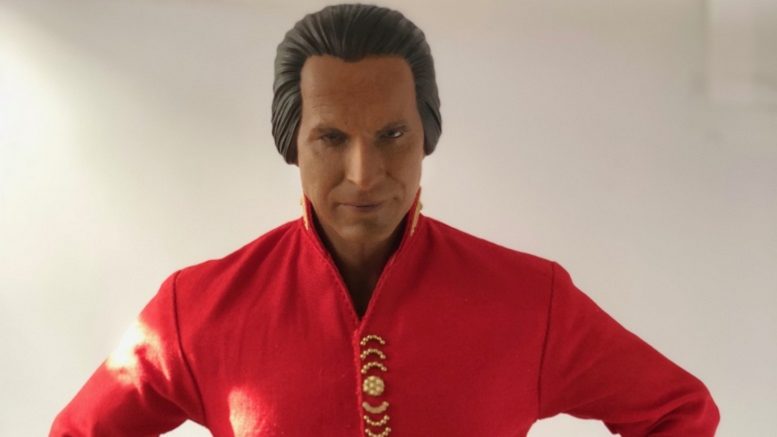
| November 27, 2017 | By: John Duchak 7 comments so far
QMx’s line of 1:6 Star Trek figures is expanding with Khan from the classic TOS episode “Space Seed.” TrekMovie got an early look just in time for today’s release.
QMx is a company known for its fine artisanship, especially when it came to their mouth-watering (and wallet-busting) artisan replica models of the U.S.S. Enterprise and other ships. But even for fans with more modest means may already have one of QMx wide selection of badges , art prints , jewelry , or perhaps a tribble .
As for 1:6 figure line, Khan Noonien Singh joins TOS versions of Captain James T. Kirk, Mr. Spock, and Dr. Leonard McCoy , as well as Captain Jean-Luc Picard in their 1:6 line.
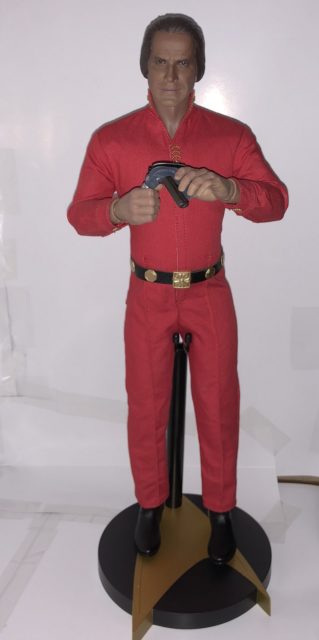
Khan’s Sculpt Just As Superior As His Intellect
Unlike other figures, such as the Select Series from Diamond Select Toys, the 1:6th Khan only comes with one head, but one is enough. This hand-painted image of Ricardo Montalban captures exactly how he looked during “Space Seed.” The figure’s face and neck have been carved to match every line and detail in Montalban’s face. His hair is perfect, pulled back as tightly as it was in the episode.
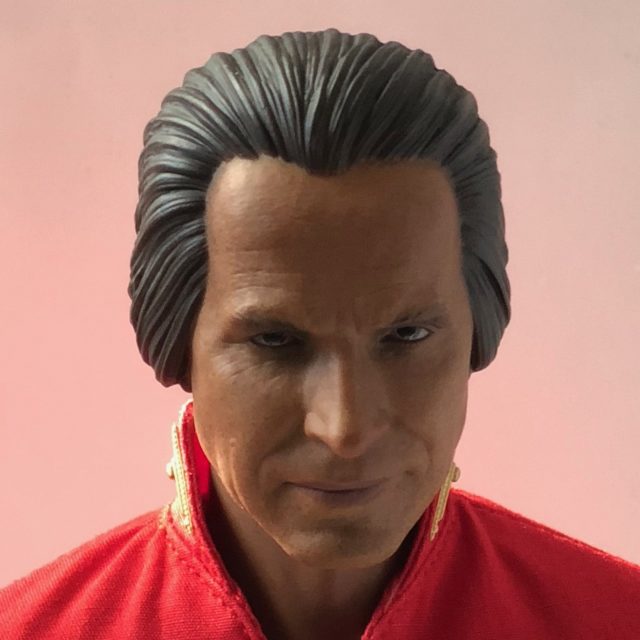
Khan stands at 12 inches tall, and the figure has over 30 points of articulation. Also included are three sets of hands, allowing Khan’s hands to match a number of different poses.
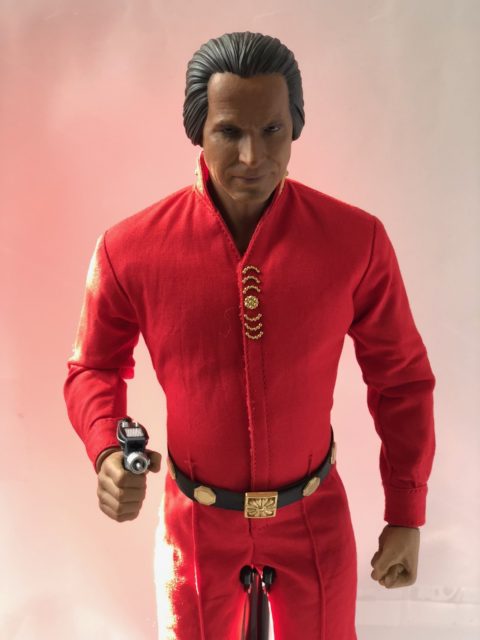
Khan’s 20th Century Clothing
While Khan wore three different costumes during “Space Seed,” this version wears the 20th-century military jumpsuit that he and his followers donned in the final act of the episode as they were taking over the Enterprise. QMx researched and matched the figure’s clothing so that they perfectly match the costume Montalban wore in the episode.
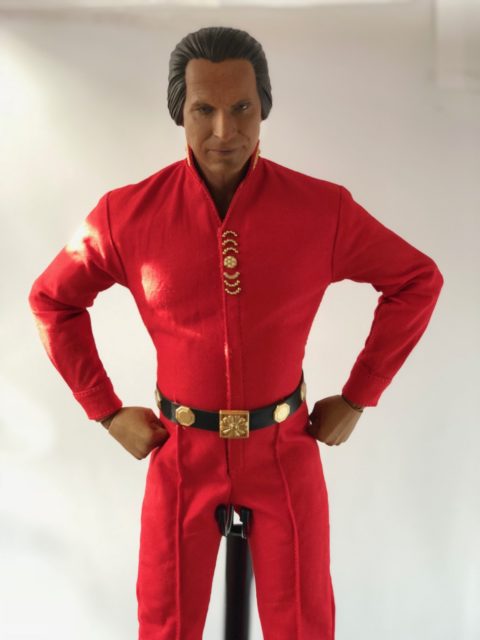
Crushing Phasers: Khan’s Accessories
One of the most enjoyable moments of “Space Seed” was when Kirk attacked Khan during their climactic battle in engineering and, upon losing his phaser, Khan crushed it in his hands in a display of his genetically-modified strength. The QMx figure comes with exactly that: a crushed phaser. The phaser has a removable handle so that you can display it in various stages of destruction.
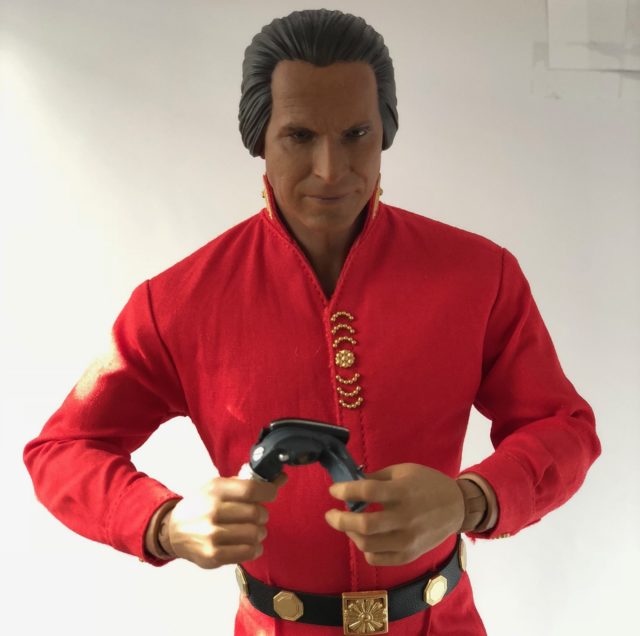
Additionally, Khan comes with the engineering rod that Kirk pulled from a console with which he used to best him. This accessory makes the 1:6th Kirk figure necessary to recreate the legendary fight scene in engineering, as it is Kirk who wields it.
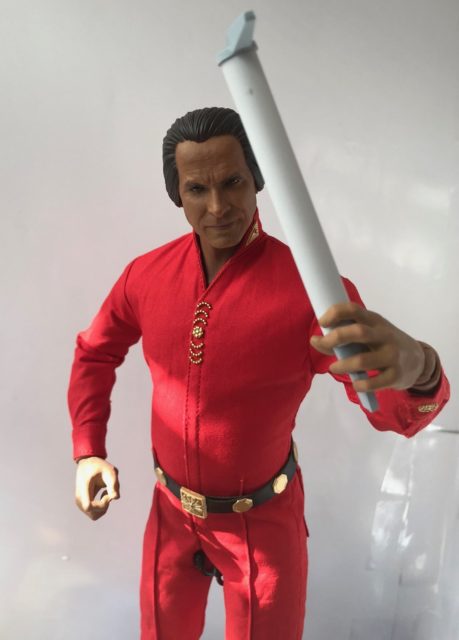
The figure comes with a round stand with a gold delta shield, just like the other TOS figures in the line. Instead of attaching a peg through a plastic boot like smaller figures do, the stand holds the figure upright with two black braces positioned at the figure’s crotch. The pair of braces also move independently of one another, allowing collectors to position Khan securely in more extreme poses.
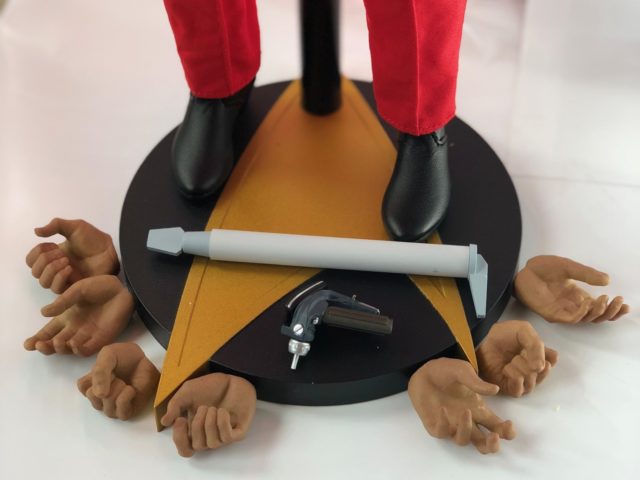
Overall, this figure is worth every penny. The size, level of detail, number of accessories, and articulation remind you of one of the most memorable TOS episodes at every glance. The QMx 1:6 Khan figure retails for $149.95 and was made available for purchase just today. You can pick on up on the QMx site .
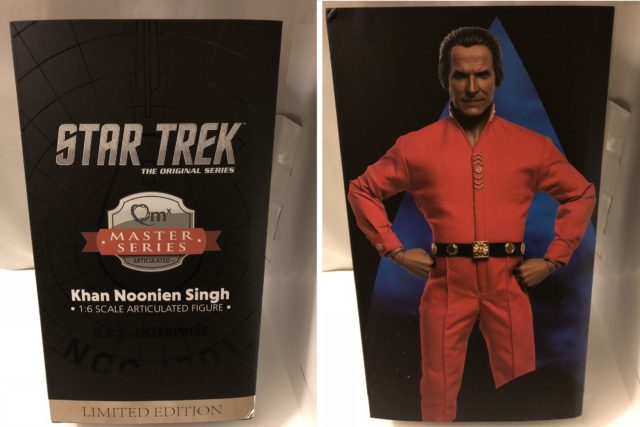
Thanks for a great review!
Is that Bill Maher?
Looks like George Hamilton or Dick Gautier (and 10 points to anybody who gets that last reference)
I got it! Loved him as Hymie.
Well, this is definitely NOT a Thing that was Rotten! (and 5 bonus points to whoever gets that reference – without resorting to IMDB [grin])
Great figure but I always cringe when I see them on those crotch grabbing stands. :)
I don’t know if it’s the angles, the lighting or what but it just doesn’t look like pictures of the prototype Khan that I’ve seen by just doing a google search on “QMX Khan”.
TOS: S1 – E22: Space Seed

Space Seed was an amazing episode of Trek, which stands the test of time, thanks to the convincing rivalry between Khan and Kirk. They really distrusted each other. Ricardo Montalban and Shatner were like two opposing forces… only one genetically enhanced. This episode was so good, that it spawned Star Trek II: The Wrath of Khan !
STARDATE: 3141.9
The episode begins with an ominous score. The kind of music that alerts the viewer that “something’s wrong” without knowing anything else. The Enterprise found an old Earth vessel (E-Y100 Class), which they determine launched sometime in the 1990s. McCoy reported that there were heartbeats detected from the ship, and equipment operating.
Spock said meteors pitted the ship’s hull, but the name of the vessel was the S.S. Botany Bay , but there were no records of a ship of this name. This ship was launched during the final World War — the Eugenics Wars. Spock said this war concerned humanity’s attempt to improve the race by genetic breeding.
Kirk gathered a boarding party composed of himself, the doctor, the ship’s historian (Lt. Marla McGivers), and a security officer. When they arrived, McGivers told Kirk that it was a “sleeper ship,” which was necessary until the year 2018 due to the great lengths of time that space travel required.
“Khan? Nothing else?” Kirk said. “Khan,” said the visitor.”
The crew walked around the ship, which was full of sleeping humans, all behind glass.
Scotty turned on the ship’s lights, which slowly revived the leader. By her comments, and the lights and soft-focus used by the director of photography, Jerry Finnerman , the viewer figures out that McGivers is smitten with this man before he even wakes up.
“From the Northern India area, I’d guess,” said McGivers. “Probably a Sikh. They’re the most fantastic warriors!”

Soon, the chamber where the leader slept stirred, and McCoy detected breathing and increasing heart rhythm. They broke the glass free him from the chamber. After some time, he came to and asked how long he had been asleep. Kirk told him that he’d been asleep for two centuries. They beamed him back to sickbay.
Scotty could find no records on the Botany Bay but reported that 72 of the travelers had survived, though they had not been resuscitated. Kirk ordered the Botany Bay be towed to Starbase 12.
In sickbay, as McCoy examined his patient, he was awed at the man’s superior respiration and heart power. As McGivers observed, Kirk said he was an improved breed of human. Later, Kirk lectured McGivers on taking a liking to their visitor.
Later, when McCoy looked in on his patient’s progress, the man grabbed the doctor and demanded to know where he was. McCoy told him that he was in sickbay, holding a knife to his doctor’s throat. The man released McCoy and demanded to meet the captain.
Kirk arrived later to answer the man’s questions. He asked first where the Enterprise was headed. Kirk said their destination was Starbase 12 in the Gamma 400 star system. The guest then asked about his people, and Kirk said there were 72 survivors.
The visitor finally revealed his name.
“Khan? Nothing else?” Kirk said.
“Khan,” said the visitor. Kirk pressed for more answers, but Khan said that he was tired, and McCoy told the captain that it would be better to wait. Khan asked if could see the schematics on the ship, Kirk showed him the screen next to the bedside, and McCoy would later show Khan how to access the ship’s records.
When Kirk joined Spock on the bridge, they spoke about the possibility that Khan could be a product of genetic selection. Spock said that he very well could be one of the “supermen” who attempted to take over the Earth in 1993. He said there were 80 or so supermen escaped, of which there were no historical records.
In sickbay, Khan got a visit by McGivers, who tried to ask him serious scientific questions. Khan turned it into a way to woo her.
That evening, Kirk welcomed Khan to a “state dinner” with the ship’s leadership team. Khan visited McGivers before the dinner and found a portrait of himself that she painted. He said he was honored. He then kissed her.
At dinner, Spock asked the tough questions while Kirk sat by and watched. Khan recognized this. Kirk then asked if Khan fled out of fear. Khan said he was never afraid. As if backed into a corner, Khan slammed his hand on the table and said that he and those like him “offered the world order!”

“We?” asked Kirk. Khan just revealed that he was one of the genetically engineered supermen who tried to enslave the Earth in the 1990s. He then went back to his quarters.
After dinner, McGivers visited Khan, who told her that he intended to take over the Enterprise . He forced her to agree to help.
Soon the crew learned that they were dealing with Khan Noonien Singh — a former absolute ruler of the Earth, who ruled over one-quarter of the planet. Kirk put a 24-hour security team on Khan’s quarters.
Kirk came to Khan, and revealed to the superman, that the crew knew who he was. Khan said to the captain that he was placed on the Botany Bay to start a new life on a new planet.
Khan told him that he was surprised how little humans had changed in the past 200 years. He was impressed by the technological advances, but he was superior to Kirk in every way. He said that he and his crew would fare well in the 23rd Century. Kirk abruptly left.

After Kirk left, Khan forced the door open and attacked the guards. At the same time, McGivers took over the transporter room, allowing Khan to beam over to the Botany Bay and wake his crew.
On the bridge, the navigator informed Kirk that they were on course, at Warp 2. Can a ship tow another while at warp speed? I guess if they make the “warp bubble” expand around the Botany Bay . But those details were never discussed.
Soon, Kirk learned that Khan escaped. The bridge was cut off, and Khan cut off the oxygen supply. Kirk, Spock, Uhura, and the others eventually succumbed. Khan took over the ship from engineering.
Later, Khan lectured the command crew, telling him that they had no choice but to join him. When they resisted, Khan showed them that Kirk was trapped in the ship’s compression chamber. Khan slowly was lowering the pressure in the chamber, which was killing the captain.
Khan told Spock that he needed him and the others to find a new planet to live on. Spock pushed back, and Khan lashed out at them, saying they would all die unless they cooperated with him. McGivers asked to leave the room.
Shortly after McGivers left, the screen with Kirk in agony turned off. Khan decided that Kirk must be dead by now, and decided to send Spock to die next. McGivers let Kirk out of the chamber, just as Khan’s men arrived with Spock. They overpowered Khan’s guard together and decided to flood the decks with gas.
The gas knocked out everyone in the meeting room, except for Khan. Kirk met Khan in engineering, which was the only location not affected by the gas. Khan surprised Kirk, and a tremendous fight between them ensued. Khan threw Kirk around like a doll, but eventually, Kirk won.
In the end, Kirk, Spock, and the rest of the command crew decided to drop Khan, McGivers, and the other survivors to be dropped off on the nearby planet, Ceti Alpha V.
Khan asked Kirk if he remembered a specific line from the author John Milton, who wrote “Paradise Lost.” Without asking any further questions, Kirk said that he had. McGivers avoided court-martial by agreeing to go to Khan.
Afterward, Kirk explained that the Milton that Khan referenced was a quote from Lucifer — “It is better to rule in Hell than to serve in Heaven.” Spock wondered what would happen to the “space seed” that Kirk planted on Ceti Alpha V.
TREK REPORT SUPPLEMENTAL:
WOW! What a great installment of Trek! But it was not perfect. Please note that in The Wrath of Khan , our villain mentioned that he never forgot Chekov’s face. But as we saw, Chekov was not yet a part of the bridge crew (Walter Koenig had not yet been cast on the show).
The only thing that was not fantastic about this one was how Kirk beat Khan, by beating him down with a metal tool from engineering. I bet Khan could have taken a more significant beating than that (like he did in Star Trek Into Darkness ).
But… that’s just a quibble. This episode is a keeper, and it set the bar high for the rest of the first season, and for all series, which followed. And quite frankly, Khan became the blueprint for all Trek bad guys. Unlike the Klingons, Romulans, Ferengi, or whoever else, Trek movies have been trying to recapture Khan and his evilness ever since.
RATING: 5 out of 5
Directed by: Marc Daniels Teleplay by: Gene L. Coon and Carey Wilber Story by: Carey Wilber Produced by: Gene L. Coon Executive Producer: Gene Roddenberry Associate Producer: Robert H. Justman Script Consultant: Steven W. Carabatsos Music composed and conducted by: Alexander Courage Director of Photography: Jerry Finnerman Art Directors: Roland M. Brooks and Walter M. Jeffries
William Shatner as Kirk Leonard Nimoy as Spock
Ricardo Montalban as Khan
Madlyn Rhue as Marla
DeForest Kelley … as Dr. McCoy James Doohan … as Scott Blaisdell Makee … as Spinelli Nichelle Nichols … as Uhura Mark Tobin … as Joaquin Kathy Ahart … as Crew Woman John Winston … as Transporter Technician
Film Editor … James D. Ballas, A.C.E. Assistant to the Producer … Edward K. Milkis Assistant Director … Michael S. Glick Set Decorator … Marvin March Costumes created by … William Theiss
Post Production Executive … Bill Heath Music Editor … Jim Henrikson Sound Editor … Douglas H. Grindstaff Sound Mixer … Jack F. Lilly Photographic Effects … Westheimer Company Script Supervisor … George A. Rutter Music Consultant … Wilbur Hatch Music Coordinator … Julian Davidson Special Effects … Jim Rugg Property Master … Irving A. Feinberg Gaffer … George H. Merhoff Head Grip … George Rader Production Supervisor … Bernard A. Windin Makeup Artist … Fred B. Phillips, S.M.A. Hair Styles by … Virginia Darcy, C.H.S. Wardrobe Mistress … Margaret Makau Casting … Joseph D’Agosta Sound … Glen Glenn Sound Co.
A DesiLu Production in association with the Norway Company
Executive in Charge of Production … Herbert F. Solow
Den of Geek
Star Trek: The Wrath of Khan Completely Changed Home Media
Without Star Trek II: The Wrath of Khan, the home video market may have never experienced that '80s boom that changed movies forever.

- Share on Facebook (opens in a new tab)
- Share on Twitter (opens in a new tab)
- Share on Linkedin (opens in a new tab)
- Share on email (opens in a new tab)
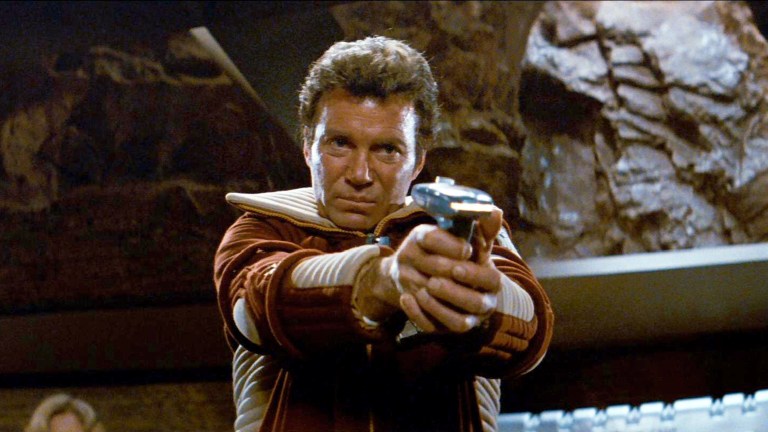
Along with being arguably the best Star Trek movie ever , 1982’s Star Trek II: The Wrath of Khan is an exceptional example of sci-fi filmmaking . It blends action, adventure, love, and horror in ways that few (otherwise great) sci-fi movies have ever come close to replicating, and decades’ worth of repeat viewings and shared praise have certainly helped capture the scope of the film’s accomplishments.
Yet, there is one part of Wrath of Khan ’s considerable legacy that remains as forgotten as the marooned settlers of Ceti Alpha V. It is the movie that not only contributed to the end of the format wars but effectively paved the way for the home media market that forever changed the way we watch (and re-watch) our favorite movies and TV shows.
The Absurdly High Costs of the VHS vs. Betamax Wars
The VHS vs. Betamax format war doesn’t even feel like a cultural skirmish these days. By the mid-1980s, VHS had established its market dominance so completely that the word “Betamax” soon became shorthand in certain circles for jokes about failed products. The popular perception was that Betamax was simply the inferior product. But the truth is much more complicated and interesting than that.
Early on, Betamax was considered to be the vastly superior format in most traditional ways. Betamax tapes offered better video quality, clearer sound, and were not only smaller than early VHS tapes but were generally considered to be more durable. If someone sat you down and showed you the Betamax and VHS versions of the same movie playing side-by-side, you would almost certainly choose to continue watching the Betamax tape. While VHS tapes and players enjoyed several improvements over the years that gradually closed the technical gap, Betamax usually offered a better overall viewing experience.
Ad – content continues below
We’re ultimately talking about a retail battle, though, and the VHS format offered several benefits that consumers felt were worth the sacrifices in quality. Namely, VHS tapes/players boasted significantly longer total recording times, which proved to be a big selling point early on when many early adopters who purchased VCRs to record programs off of their TVs.
VHS manufacturer JVC was also much more willing to license its technology out to other companies early on, whereas Sony was comparatively more protective of its Betamax technology. Even when given the choice between those formats, companies soon discovered that VHS players were often much cheaper to manufacture. That also meant that VHS players and tapes were cheaper for consumers.
However, it’s also important to consider that both formats were ludicrously expensive for the average person. The first Betamax players typically retailed for around $1500 to $2000 (or more) for a few years after they debuted in 1975 . Adjusted for inflation, that would be around $8,500 to $11,000 today. Comparatively, you could buy a VHS player for around $1,000 to $1,500 when it launched in 1977. Those prices would fluctuate over the years, but even by 1983, a VHS player would typically still run you about $500 (around $1500 today).
Worse was the cost of individual movies. While blank tapes could be purchased fairly cheaply (relative to the absurd costs noted above, that is) purchasing a tape of a major new movie on tape would typically cost you about $80-$100 up until around the early-to-mid ‘80s.
Again, the exact prices tended to fluctuate, but the point remained the same. Given the investment required, Betamax and VHS manufacturers typically saw the home media market as a concept that only appealed to wealthy enthusiasts. Even then, the thought was that those who purchased players would rely on recordings for entertainment, and those who did purchase movies would rent them from video stores and other outlets that were part of studios’ wholesale business strategy.
The thought of owning a personal library of movies was an almost unfathomable luxury at that time. To change that, a major studio would have to boldly go where no studio had gone before.
Planting the Space Seed
By the early 1980s, some much-needed price drops on Betamax and VHS players allowed more people to finally get in on the home media market. It became clear that more and more people at that time were buying VHS players over Betamax players due to their lower prices, greater array of retail options, and the natural momentum of social adoption. It just made more sense to choose VHS over Betamax. The more people you knew who had the same media format as you, the easier it was to trade tapes and other resources.
Get the best of Den of Geek delivered right to your inbox!
Even still, studios largely refused to budge on the price of individual movie releases. It must have seemed foolish to lower the prices of those releases when most of those studios were still targeting wholesale buyers. Why lower the price for those buyers when you didn’t have to, and if an individual did want to spend around $100 for the privilege of owning a blockbuster movie like Raiders of the Lost Ark or Star Wars …well, so much the better.
But then, in 1982, Paramount decided to try something pretty bold. To help promote the theatrical release of Star Trek II: The Wrath of Khan , they released The Original Series episode that set up the movie ( “Space Seed” ) as a standalone VHS tape. The front of that tape even promoted the release as “The Episode That Inspired Star Trek II: The Wrath of Khan .”
Yet, even Paramount wasn’t bold enough to charge full price for a VHS copy of a single episode from a 16-year-old TV show. Instead, they released “Space Seed” at a special reduced price of $29.99 ; significantly cheaper than just about every other VHS on the market. There is little documentation about the logic behind the decision, but the idea seems simple in retrospect. Paramount likely guessed that hardcore Star Trek fans would jump at the chance to own even a piece of the series they loved so much. Though they must have been hopeful that the release’s low price point would appeal to even more people than that, it’s hard to imagine there were realistic expectations that “Space Seed” would become a major retail hit.
Yet, that’s exactly what happened. That $30 copy of a single Star Trek episode reportedly outsold full-length modern movies that debuted at full retail prices. Did that mean that a surprising amount of people were willing to pay for VHS copies of TV episodes? Perhaps, but the real message was that the market for home media releases was larger than anyone had previously anticipated.
The Math of Khan
To test that theory, Paramount decided to release the VHS version of The Wrath of Khan for $39.95 (about $40 less than the average cost of a VHS new release at that time). The Betamax version of the movie reportedly launched for a similar price, though that proved to be a somewhat irrelevant factoid for reasons we’ll soon discuss.
In any case, take a moment to appreciate the risk Paramount was taking. It wasn’t just that most people didn’t buy many tapes; it was the fact that most people didn’t even think to buy tapes in the early ’80s. For Paramount’s move to pay off, they would need to get a record number of people to both open their wallets and change their hearts and minds. Anything short of a historic success would have left the studio with the painful realization that they were better off focusing on the rental market as their competition was still doing.
Thankfully, the gamble paid off. Wrath of Khan reportedly sold around 120,000 copies , which doubled the most optimistic internal expectations for its retail performance. It was not just an overwhelming retail success, but a moment that Paramount believed represented a seismic shift in the foundation of the entire entertainment industry. In fact, in an ad that promoted Wrath of Khan as an all-time best-seller, Paramount bragged about the risk they took in their decision to make “buyers out of renters.”
Of course, Star Trek wasn’t the only property pushing increased VHS sales at that time. By the early 1980s, more people were also buying pornography tapes, and an increasing number of porn studios were putting their titles on VHS due to its lower cost and growing adoption rates. They didn’t exactly take out the kind of full-page industry ads that Paramount did to celebrate their successes, but they certainly played their part.
Even still, widespread changes in the industry weren’t exactly immediate. Some subsequent major releases still debuted at “full” price, and video rentals remained a popular and more viable option for many. Gradually, though, studios felt the winds of change blowing and began experimenting with lowering tape prices to appeal to a market that the movie industry had once undervalued.
By the time Paramount lowered the price of the Top Gun VHS to a meager $26.95 as part of that release’s massive promotional campaign (and record-breaking sales), it was clear that the home video market was no longer going to be dominated by whales and rental retailers. Soon, almost everyone would be able to build a home library around that Star Trek II VHS they likely owned.
Never Underestimate Star Trek Fans
While Star Trek II wasn’t quite a killing blow in the VHS vs. Betamax format war, its release represented a point of no return that would ultimately seal Betamax’s cultural standing in the minds of many. The success of Wrath of Kahn showed just how important price was when it came to home media adoption.
Sony tried their best to change some of their policies to turn Betamax into a more retail-friendly format, but in the post- Wrath of Khan world, it just wasn’t enough. The dream of owning your favorite movies was no longer a Lifestyles of the Rich and Famous luxury but a reality made possible by VHS. While Betamax would remain a viable option in professional settings that valued its technical qualities, Sony essentially conceded the format wars in 1988 when they released their first VHS machines.
Theoretically, any other major release around that time could have had the impact that Wrath of Khan did had they been released at a similarly generous price point. Yet, it always felt appropriate that it was Star Trek that proved to be the cornerstone of many ever-growing home media libraries.
At a time when studios asked, “Are people really willing to pay that much money for this?” Star Trek fans answered with a resounding “Yes.” It didn’t hurt that Wrath of Khan was so entertaining and rewatchable. If you were only going to own one movie, it was a great one to own.

Matthew Byrd | @SilverTuna014
Matthew Byrd is Games Editor at Den of Geek and an entertainment enthusiast living in Brooklyn. When he's not exploring the culture of video games, he's…
- More to Explore
- Series & Movies
Published May 8, 2024
Top Crew Moments that Defined the Kelvin Timeline
Revisit the Kelvin Timeline for the 15th anniversary of 'Star Trek.'
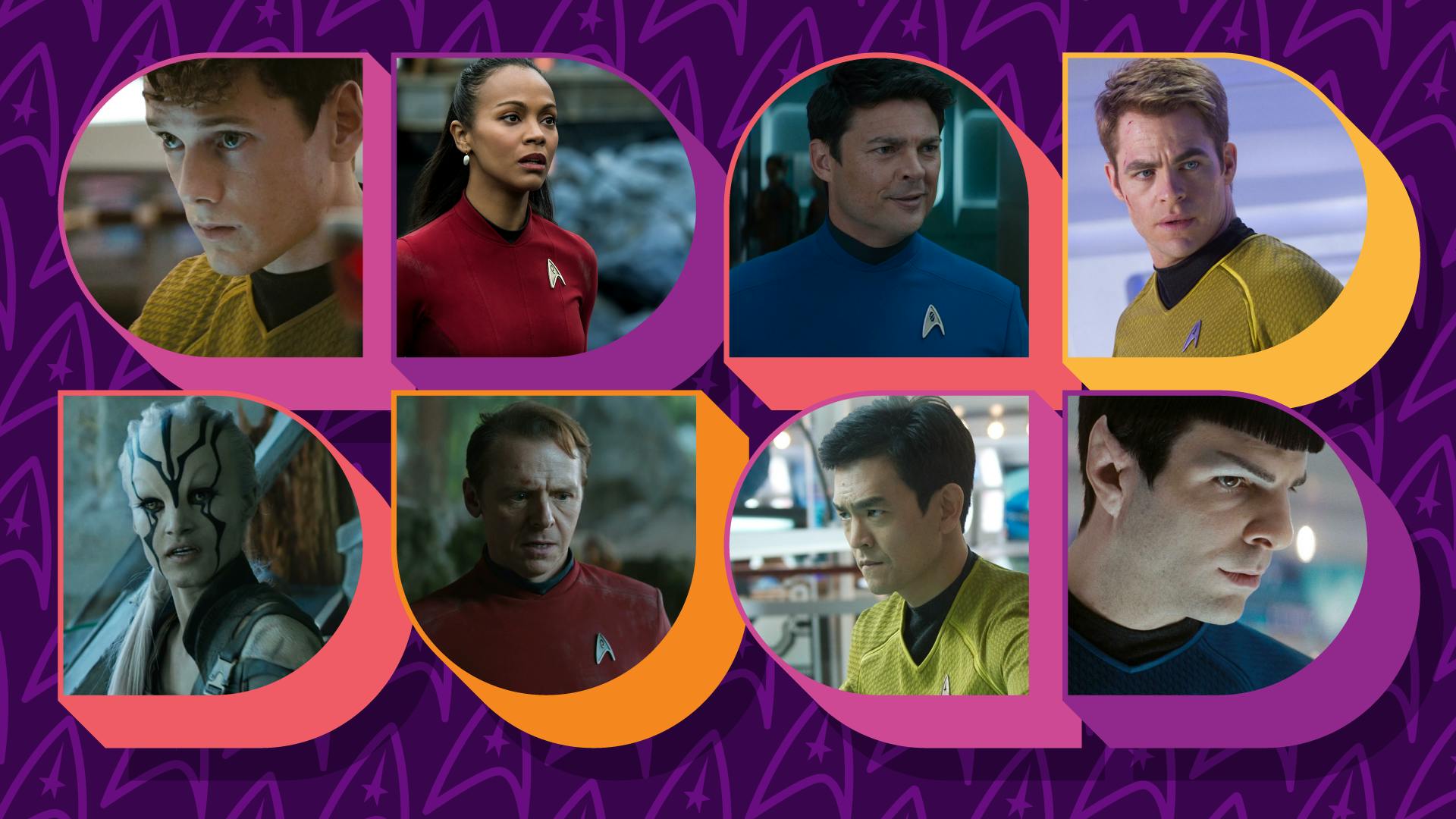
StarTrek.com
15 years ago, Star Trek (2009) created an alternate reality universe known as the Kelvin Timeline. In the parallel world of this film, and its sequels Star Trek Into Darkness and Star Trek Beyond , a retaliatory attack by a Romulan miner named Nero sets off a chain of events that forever alters the destiny of the U.S.S. Enterprise NCC-1701.
In this timeline, James Kirk loses his father, George, and is a reluctant recruit to Starfleet Academy in 2255. The half-human Spock witnesses the destruction of his home planet Vulcan; Uhura, a xenolinguistics expert, is in her early days as a cadet; and engineer Montgomery Scott is an accidental addition to the crew. While the alterations in the Kelvin-verse range from minute to major, all have an impact on the time continuum that sets everyone down a familiar yet different path from their TOS counterparts.
In honor of the 15th anniversary of Star Trek , we’ve rounded up some of the key crew moments that define the Kelvin Timeline. While fan reception varies across all three films, they do expand the lives of the TOS crew from their maiden voyage, their first five-year mission, to their fall, and reunion at Yorktown.
Captain George Samuel Kirk: Sacrifice of the U.S.S. Kelvin
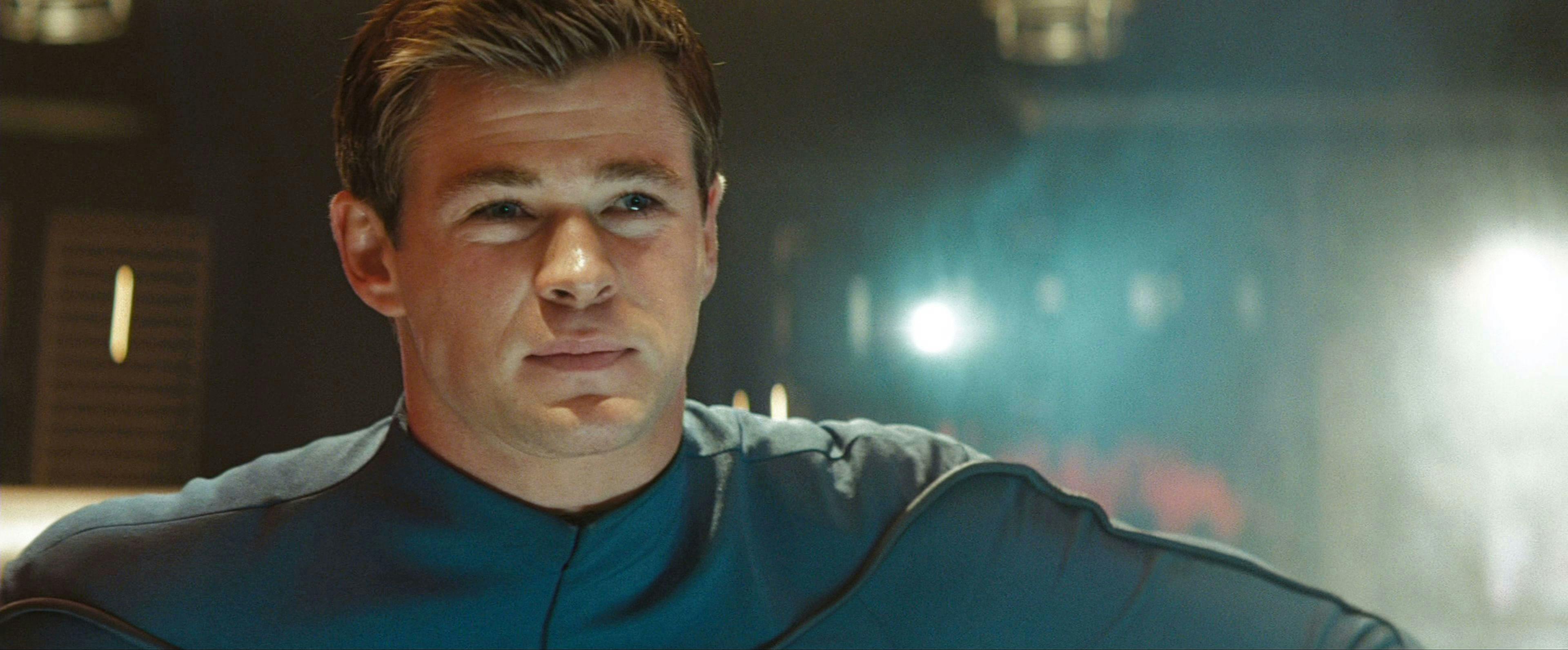
Star Trek (2009)
The Kelvin Timeline starts with the death of George Kirk, since the alternate reality established in Star Trek is built on Kirk's sacrifice aboard the U.S.S. Kelvin .
Following an attack by Captain Nero, a 24th Century Romulan bent on revenge for the loss of his home world, George Kirk becomes acting command for Captain Richard Robau. With a passenger load of 800-plus on his shoulders, Kirk leads decisively to evacuate the Kelvin and destroy Nero's mining vessel Narada . His final moments are spent securing the life of his pregnant wife and child, just moments from birth. Captain George Kirk went down with the Kelvin , but not before naming his son. And not before saving the lives of nearly all its crewmembers in a legendary maneuver that involved manually piloting his ship into the Narada to give survivors more time. While his son, James, grew up without a father, George's influence was never out of reach. His DNA for steeliness was a blueprint, dad to son.
As Christopher Pike told James when recruiting him to Starfleet, George Kirk "didn’t believe in no-win scenarios."
Captain James T. Kirk: Going Down with the Enterprise
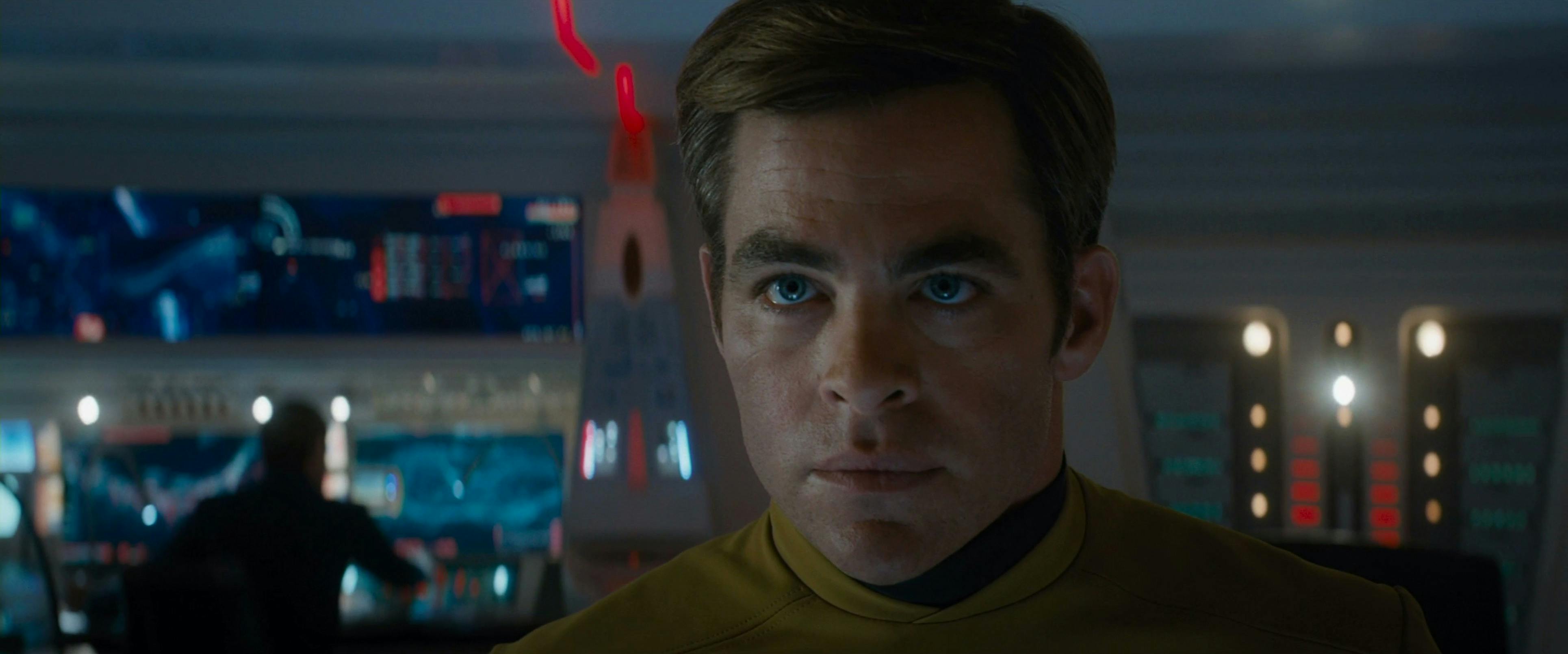
Star Trek Beyond
Yes, the captain's sacrifice to the warp core in Into Darkness could top the best of Kirk in the Kelvin Timeline. But even more real is the loss of the Enterprise in Star Trek Beyond .
Halfway through its first five-year mission, the ship's saucer section is destroyed by Krall, a former Federation officer who is now the mutated leader of the Swarm. Krall's advanced tech takeover is an eerie callback to the loss of the Kelvin and George Kirk in Star Trek 's opening moments. Jim Kirk confronts the exact decisions his father faced in his final moments, and he faces the inevitable destruction of the Enterprise with the same head-on decisiveness. The crew comes first, always. That principle is also exemplified in Kirk's impassioned plea to Admiral Marcus in Into Darkness when the ship is threatened with extinction. No one else is responsible for Kirk's orders, and he's always made that clear.
Spock: (Alternate) Future Planning for the Past
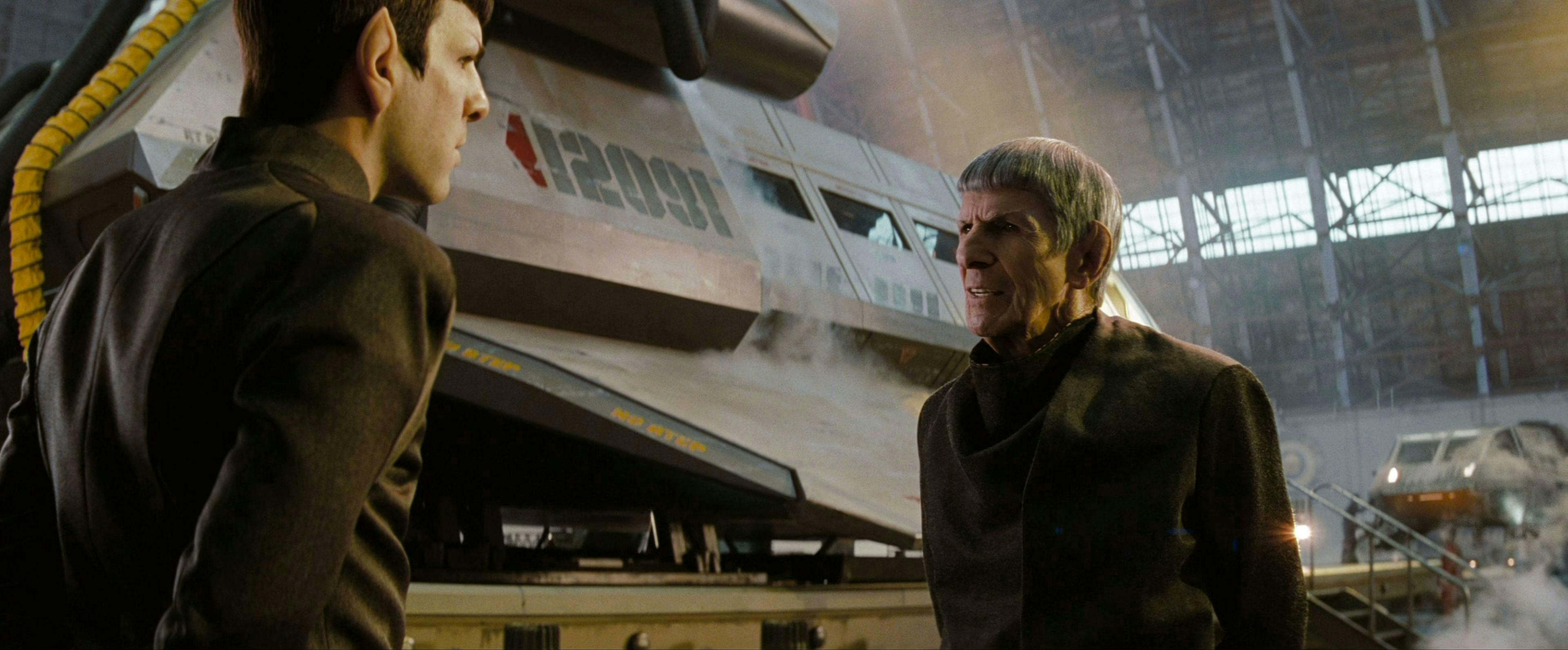
Spock's best moments in the Kelvin Timeline are the conversations he has with himself. He is an (alternate) future planner, and Ambassador Spock is the Prime messenger. There are two "hinge" events that have caused this parallel, divergent timeline — the destruction of Romulus around 2387, and the destruction of the U.S.S. Kelvin in 2233.
Prime Spock sets up his younger, alternate reality self with critical information, but nothing can stop the death of Vulcan and its billions of inhabitants. Ambassador Spock also convinces Kirk, while marooned on Delta Vega, to elicit a strong emotional response from his younger self so that Captain Spock "realizes" he is unfit for command. The Ambassador knows that the survival of the Enterprise relies on Kirk in the captain's chair, with Spock's measured logic guiding the captain with computer-like precision.
In Into Darkness , Ambassador Spock also warns the Commander of what's ahead. Because of the Ambassador's uncharacteristically strong response, Spock understands the full threat of Khan. He warns Kirk, repeatedly, that Khan is not to be trusted, even as a temporary ally. If only Kirk took the note.
Lieutenant Hikaru Sulu: First Enterprise Mission
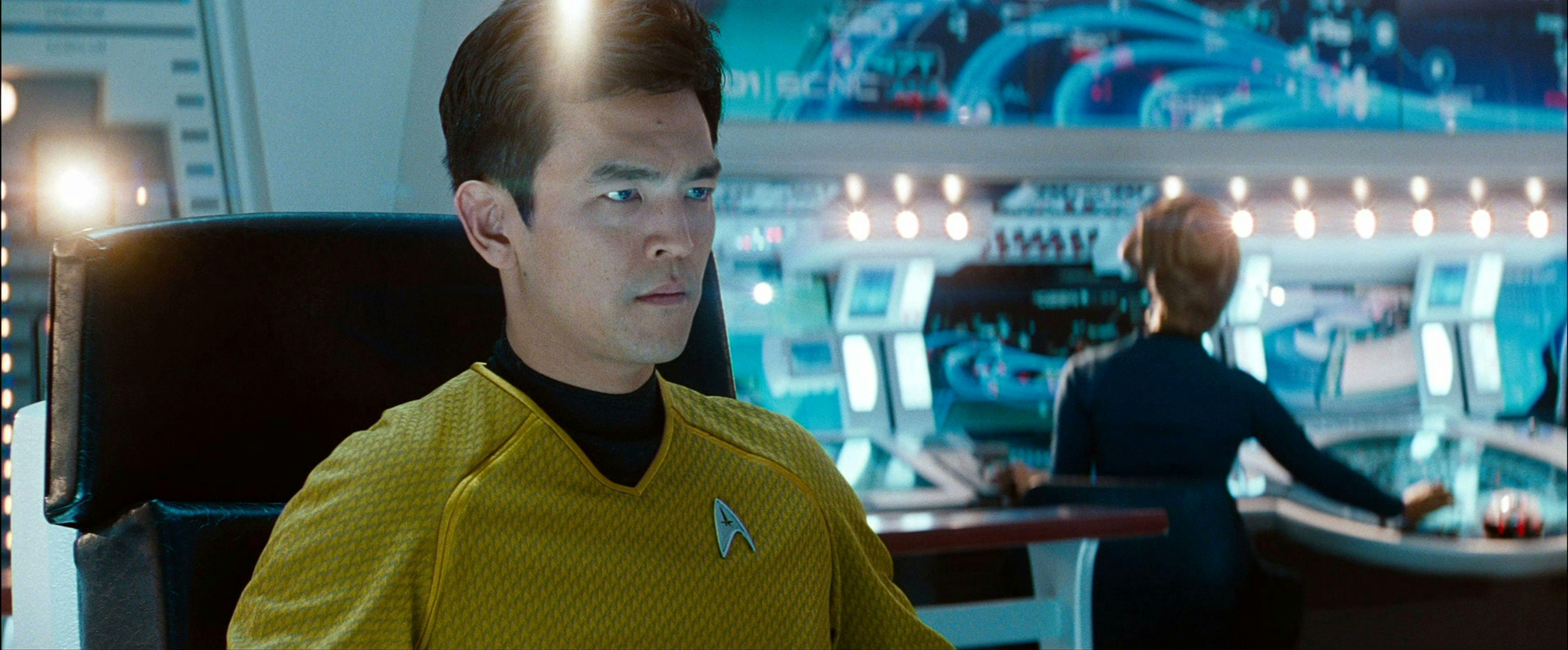
Star Trek Into Darkness
Lieutenant Sulu stands out on his first Enterprise mission. As the responders to the Vulcan distress signal in Star Trek , Sulu and a crew of fresh-faced cadets mobilize under Pike's command. While first day jitters cause Sulu to forget to disengage the Enterprise 's equivalent of a parking brake, we'll cut him some slack. Three minutes into his maiden voyage, Sulu pilots the Enterprise straight into Nero's trap, and is forced to pull off an evasive maneuver in a space field littered with what's left of a Federation Starfleet. And he can't go to warp.
Sulu's first "away mission," if parachuting into the Vulcan atmosphere to board and overpower the Narada qualifies, is also memorable. We learn just how much hand-to-hand combat he's working with when Sulu saves Kirk from two Vulcans with expert fencing skill. A sophisticated addition to a Starfleet resume and, in Sulu's case, the saving grace for one of the rockiest first flights in Star Trek history. Don’t test Sulu. If you do, "you will fail."
Lieutenant Nyota Uhura: Taking Down Khan
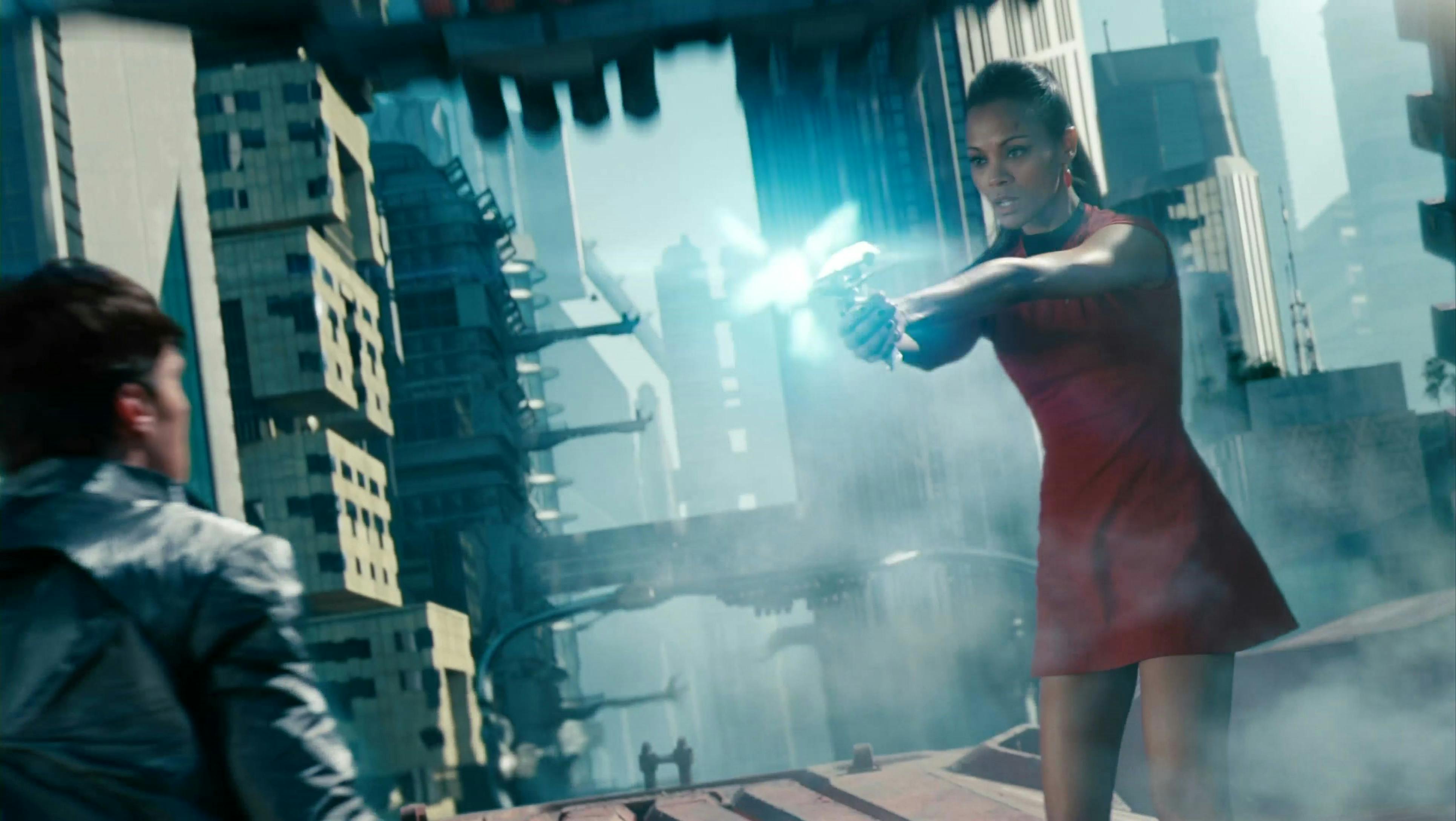
Lieutenant Uhura delivers the final blow to Khan in Into Darkness . When Bones discovers that Khan's blood is needed to save an irradiated Kirk, the Lieutenant beams down with seconds to spare to relieve Spock from a losing battle. Uhura's fight with Khan is also a resolution to her turmoil at the start of Into Darkness .
Following Spock’s near-sacrifice on Class M planet Nibiru, Uhura struggled to understand how the person she loved could end it all so easily. While fighting Khan, Uhura is the one who is prepared to die, demonstrating just how deep her bond with Spock runs.
Montgomery Scott, Chief Engineer: Standing on Principle
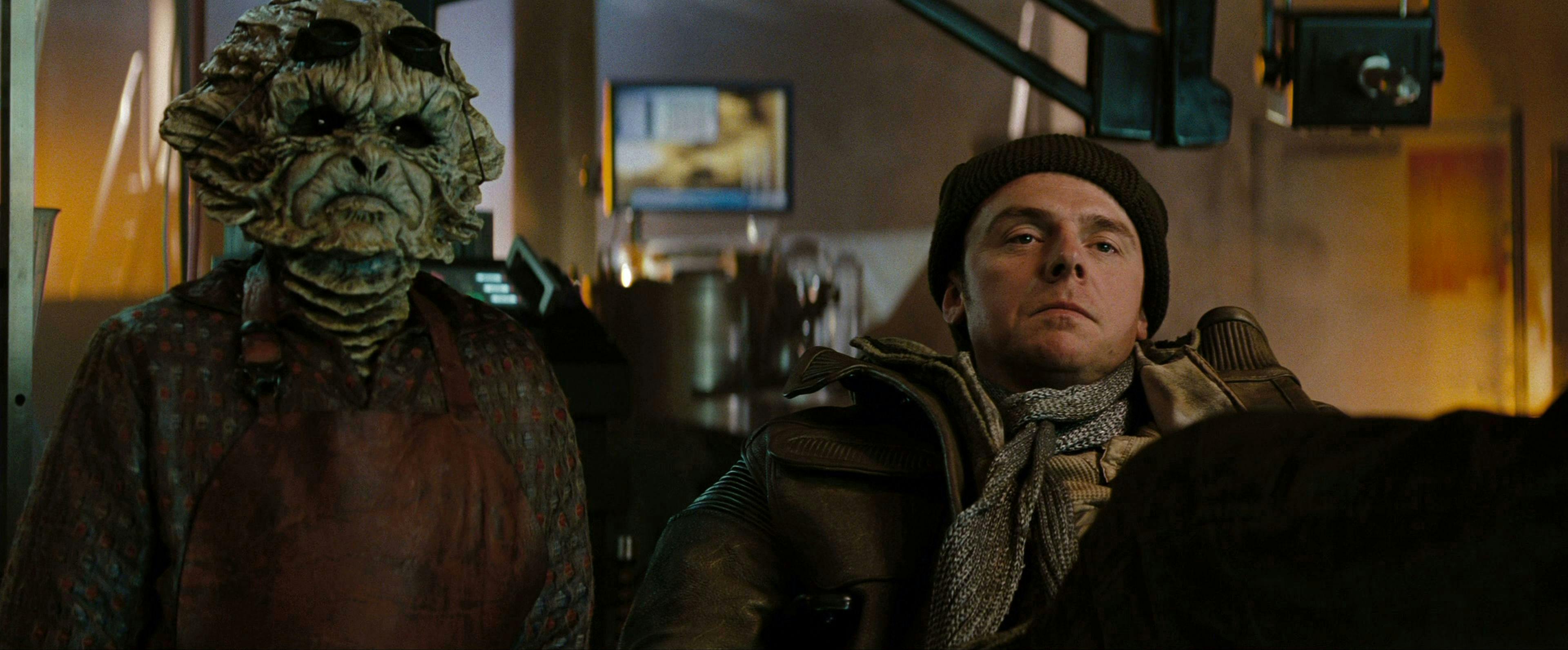
Montgomery "Scotty" Scott gets a lot of play in the Kelvin Timeline as the inventor of transwarp beaming and as the Enterprise 's Chief Engineer. Kirk and Ambassador Spock first encounter Scotty in the Federation outpost on Delta Vega. His assignment is bleak, cold, and lonely, so he's only too happy to beam aboard the Enterprise while it's mid-warp even at risk of death. (Good thing too, 'cause he almost dies.)
To Scotty, the Enterprise represents limitless engineering possibilities. He is a veteran man of science, equally fascinated by the dated technology of the U.S.S. Franklin in Beyond . There is no challenge that Scotty doesn't match with grit. The rare exception is when he says "no" to Kirk in Into Darkness for all the right reasons. Scotty refused to support Starfleet's military operation against "John Harrison," telling Kirk that he considered himself an explorer. A man with a mission and a conscience.
Dr. Leonard "Bones" McCoy: Saving Jim Kirk's Life
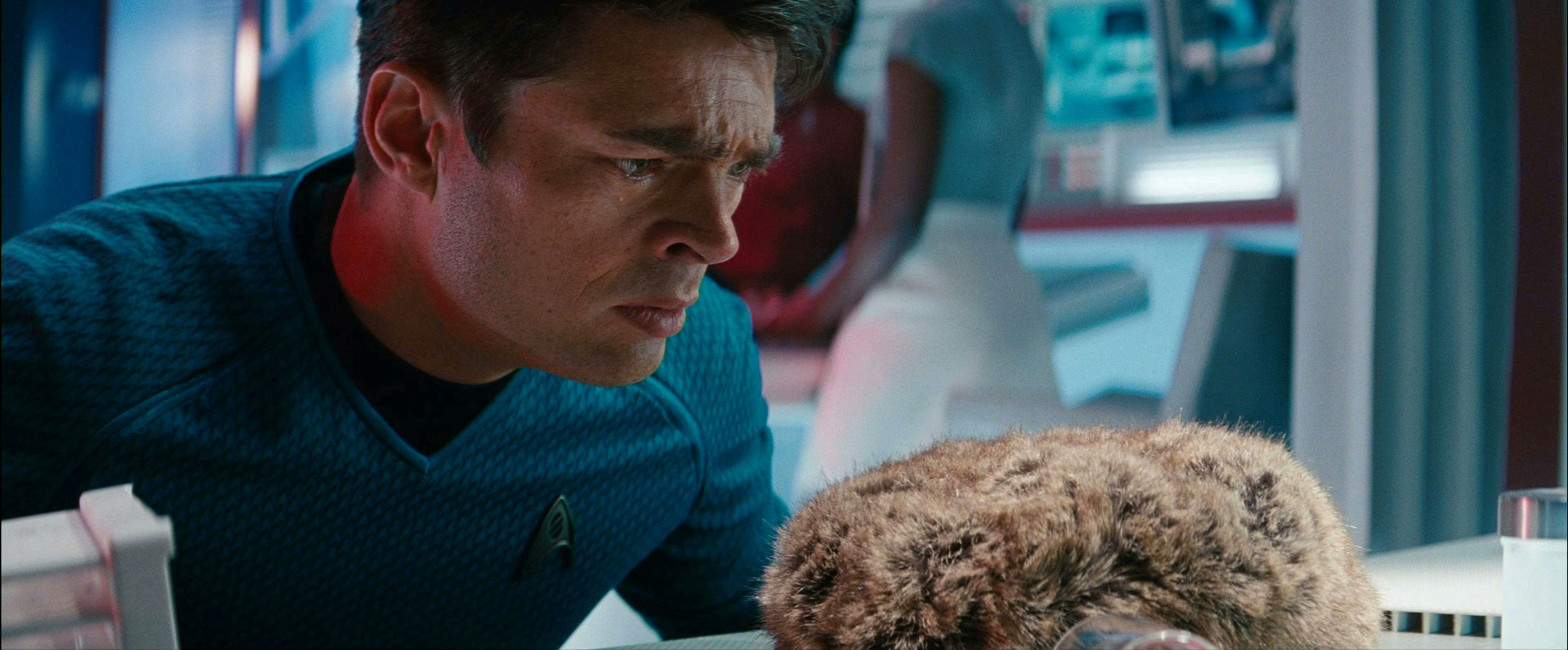
Bones gets two "Best in Crew" moments as the Enterprise 's Chief Medical Officer. The first — inoculating and dragging Jim Kirk aboard the Enterprise in Star Trek . The second — saving Kirk's life in Into Darkness .
In order to cripple the U.S.S. Vengeance that was overtaken by Khan, James Kirk needed to stabilize the Enterprise by reactivating the ship's engines and weapons. So, he enters the warp core, sans containment suit, flooding himself with a deadly dose of radiation. The Enterprise is now down a captain, but at least it's no longer hurtling towards a fiery reentry on Earth. Enter Bones with a bit of Tribble inspiration.
After the successful capture of Khan on Qo'noS, Kirk requested that Bones test the blood of the madman to unlock the secrets of his superhuman healing and strength. Bones delivered, injecting a sample of Khan's blood into a Tribble. When Bones notices that Khan's super-blood reanimates that same Tribble from death, Kirk is taken off the cryotube, Khan is beamed back to the Enterprise , and an 11th hour blood transfusion brings Kirk back from the land of death.

Ensign Pavel Chekov: Manual Override Award
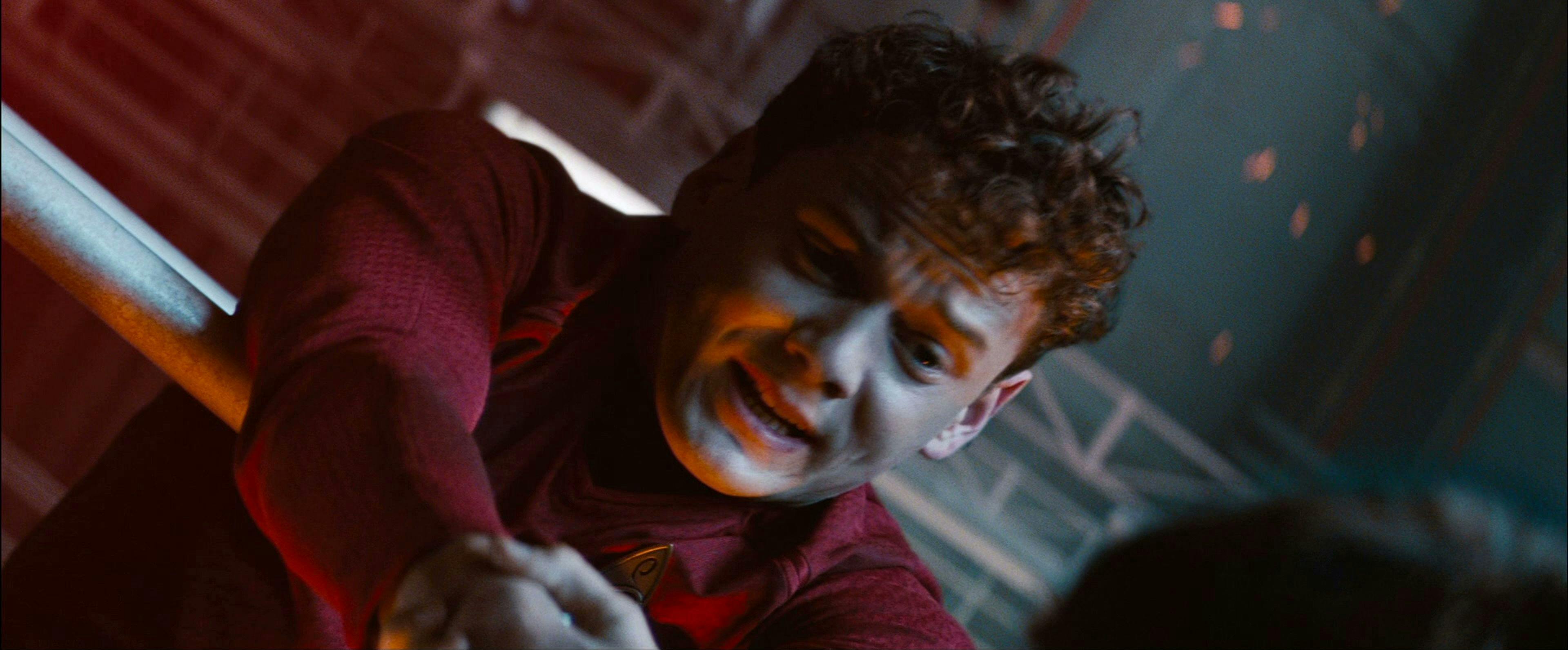
Ensign Pavel Chekov deserves a pip for dealing with multiple, catastrophic tech failures in the span of Into Darkness . When Chief Engineer Mr. Scott fails to persuade Kirk to disarm the Enterprise 's torpedoes, or else , the ship experiences a warp core coolant leak that removes their ability to evade Khan or counterattack. And, since Scotty handed in his resignation to avoid this preventable disaster, Chekov patches up the pieces. Throughout Into Darkness , the MVP Ensign scurries, dodges, and races against the ticking bomb of Khan to get the Enterprise back in semi-decent shape.
In the film's final showdown, the Enterprise and the U.S.S. Vengeance are both inoperable. They are trapped in Earth's gravitational field above San Francisco, plummeting towards certain death. Enter Chekov with his "right time, right place" talent. Making one of the most impressive plays in the Kelvin-verse, Chekov catches Kirk and Scotty from freefall in their race to get the warp core online.
Jaylah: A Warrior Survives Altamid

startrek.com
Star Trek Beyond is a survivor movie, and Jaylah is the ultimate survivor.
A crewmember that started as an ally, Jaylah is a member of an unknown humanoid species. She becomes a friend to Starfleet by sharing a common enemy in Krall, who also destroyed her people. For a handful of years, she was marooned on the planet Altamid, surviving and building a home out of a 2160s Federation starship. Jaylah's mastery over the legendarily lost U.S.S. Franklin makes her a best in (honorary) crew. By engineering defunct, century-old alien tech, she uncovers the secrets of an ancient vessel. Jaylah survives by camouflaging the ship with holograms, alarming it with traps, and listening to music on VHF.
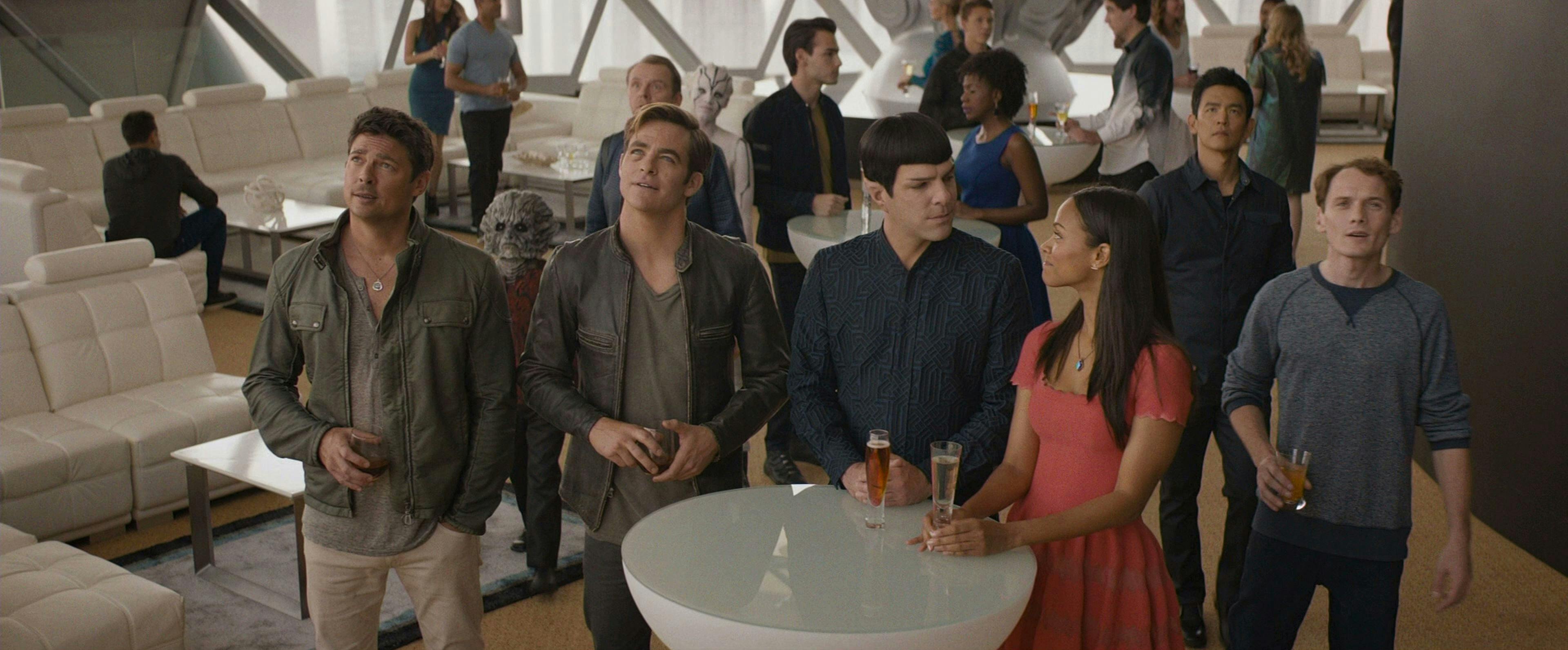
By the end of Beyond , the reconstruction of Enterprise -A is already underway. The captain has refused an appointment to Vice Admiral so he can still fly, and Ambassador Spock is dead, leaving Commander Spock on a singular timeline journey. Uhura recommits to Starfleet, Jaylah gets a bid to join the Academy, and Bones all but says that he'll go wherever Kirk goes. As for the rest of the crew? The five-year mission remains uncharted, but all have their eyes on Enterprise -A.
To revisit the entire Kelvin Timeline, watch Star Tre k , Star Trek Into Darkness , and Star Trek Beyond . Bring it home today .
Get Updates By Email
Robyn Belt is a writer, editor, and journalist (Startrek.com, Marvel.com) who loves thinking about the real and speculative science of Star Trek. DS9, TNG, SNW super-fan. Find her on Twitter @robyn_belt or Threads @robynbelt_.
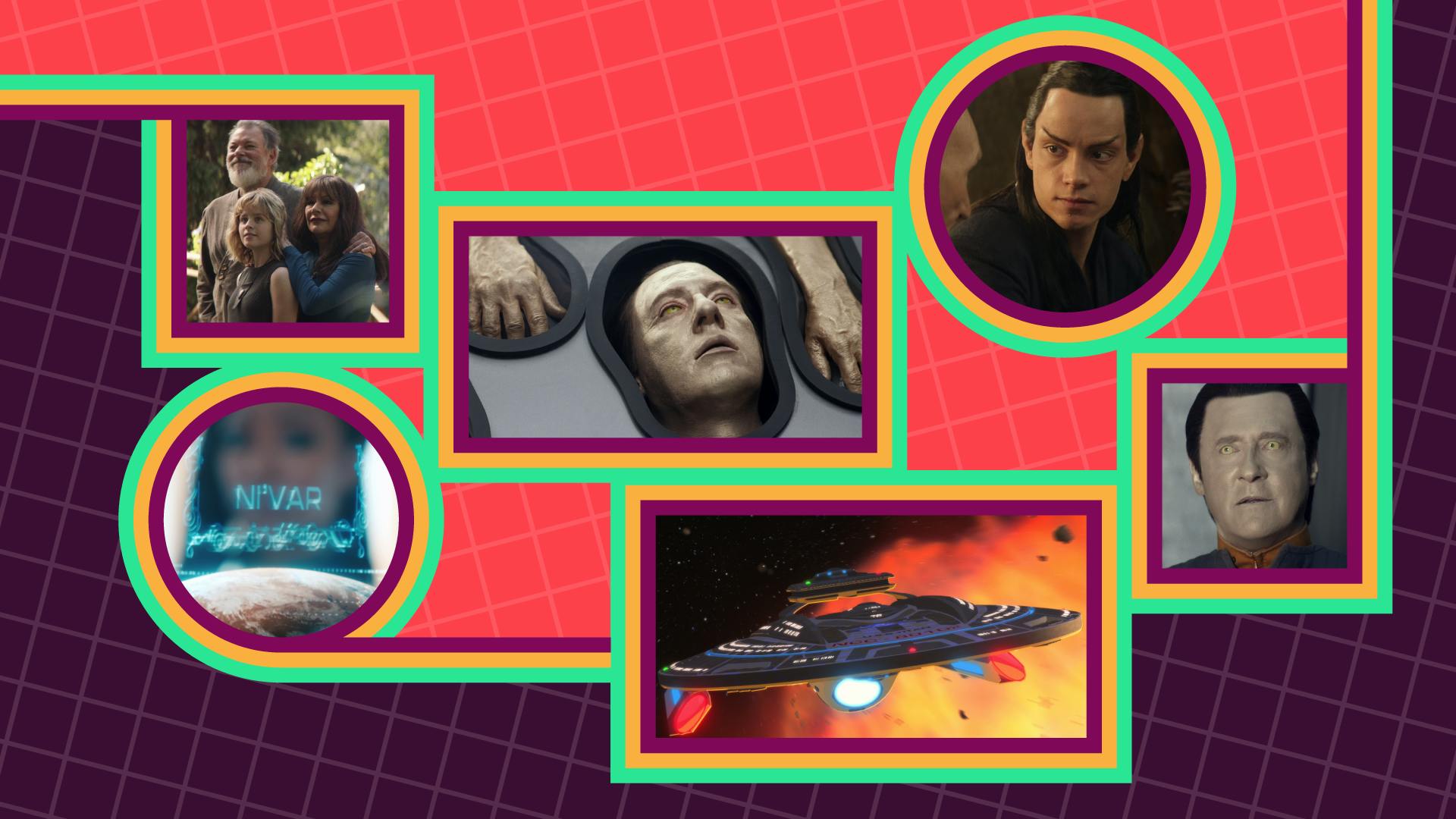
- The Inventory
Star Trek' s 2009 Reboot Changed Everything
J.j. abrams and company didn't just revive star trek, they steered the franchise—and hollywood—in a new direction..
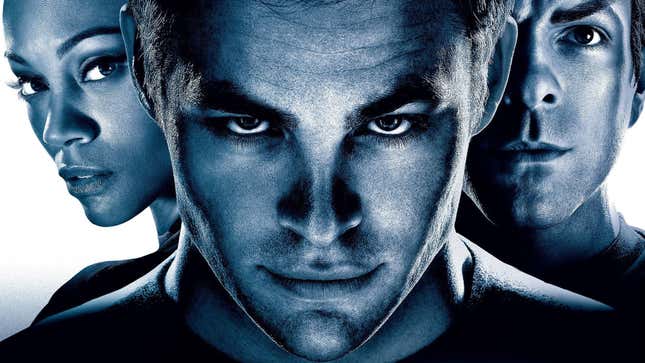
Star Trek has been an important fixture of sci-fi TV for decades, and alongside its continued existence, movies have helped further flesh out the characters. But in both the movies and TV, the early 2000s weren’t kind to the franchise: 2002's Star Trek: Nemesis was a critical and commercial disaster, and Star Trek: Enterprise had a respectable four-season run, but the shortest of the shows since the original series. Change was in order, and it was eventually decided that would take the form of a reboot that took everyone by surprise.
Related Content
Related products.
Star Trek— that is, the reboot film released May 8, 2009—is one of those movies that showed up at just the right moment. At the time, movies based on old TV shows like Starsky & Hutch and Charlie’s Angels had found commercial successes, which gave this reboot some cultural context. It also helped that it was being helmed by a trio of filmmakers who knew how to make hits: J.J. Abrams was still riding the high off directing Mission: Impossible 3 (speaking of movies based on old TV shows) , along with the almost-ended Lost and the still young Fringe . Writers Roberto Orci and Alex Kurtzman had written Mission and were further on Paramount’s good side with the first Transformers movie. If there was anyone who could make a new Star Trek flick that’d get anyone’s attention, for better or worse, it’d be these guys.
It really can’t be understated how much Paramount was banking on this new Star Trek being a hit back then. The studio wanted, more than anything, to get audiences to care about Star Trek again, and how best to do that in the 2000s? By hyping up its action scenes and Kirk being quite the ladies man. That didn’t entirely go over well, much like Abrams’ comments that the movie would mainly be for non-Trekkies. Even with that, the movie couldn’t help but look interesting. Those trailers didn’t tell you a dang thing about its actual plot, but they had good vibes, and made you want to see how the Enterprise crew would come to be the adventurers our parents and grandparents had fallen in love with back in their day.
And fall in love, people did: the reboot movie was met with critical acclaim and later four Academy Award nominations, ultimately winning one for Best Makeup and being the only Trek movie to net an Oscar. Despite mixed reactions on the movie splitting off into its own timeline, critics and audiences loved the young cast’s takes on the original characters—especially Zachary Quinto’s Spock and Zoe Saldana’s Uhura—and their chemistry. With a $385.7 million box office, Star Trek succeeded in making people care about the franchise once more. But its high ended up coming down quicker than you’d think, and in the years since, the movies have been marooned in space.
A few years later, 2013's Star Trek Into Darkness left an odd taste in audiences’ mouths. It still made money, but something about it felt off: maybe it was how it did a more convoluted retelling of Wrath of Khan, or maybe it can be owed to its very weird B-plot with 9/11 parallels that feel like they belong in a completely different movie (or another franchise entirely). Star Trek Beyond , conversely, went for a considerably simpler approach and just functioned like a regular episode of the show. That energy, combined with a still- incredible needle drop , was the right move, even if the film wasn’t a smash hit when it dropped in 2016. Paramount’s spent years trying to get a fourth movie off the ground since then, and it’s anyone’s guess as to if it’ll actually happen.
Things have gone much better over in TV land: Star Trek: Discovery and Lower Decks , a pair of well-liked shows, are both ending after their respective fifth seasons—a run that feels like a miracle these days. Star Trek: Picard gave Next Generation fans the legacy sequel they’d been wanting for years, and Star Trek: Prodigy , despite how messily its schedule was handled, brought younger audiences into the fold. It’s Star Trek: Strange New Worlds that’ll be spearheading future TV plans, which currently include a Starfleet Academy show and the Paramount+ film focused on Michelle Yeoh’s Discovery character Phillipa Georgiou .
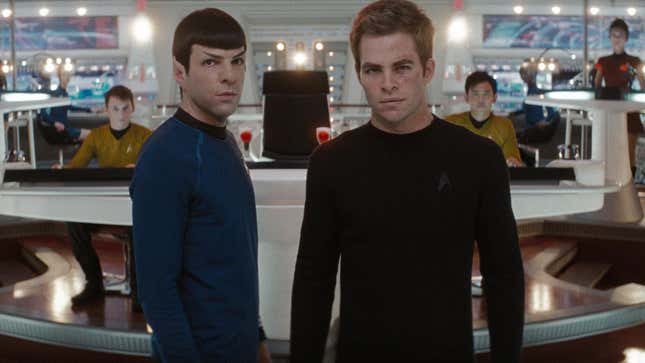
Star Trek 2009 's biggest aftershock came outside of its franchise with the big reboot and legacy sequel boom of the 2010s. New takes on Teenage Mutant Ninja Turtles, Power Rangers, RoboCop , and Evil Dead were born from this movie’s success, even if it was just to revitalize its own series. Abrams, Orci, and Kurtzman went on to become even bigger names in Hollywood: the former famously went on to revive Star Wars for the big screen, and is a producing powerhouse. Orci and Kurtzman went on to be involved with the Amazing Spider-Man movies, and create or executive produce shows like Sleepy Hollow and Fringe . When the duo separated, Kurtzman—following his directorial debut The Mummy , which failed to launch Universal’s Dark Universe—effectively became Star Trek’s equivalent to Kevin Feige. Orci, last we heard, was writing a Spider-Man adjacent movie for Sony that’s gone quiet in the years since its announcement.
All-in-all, Star Trek was a game-changer, and for better or worse, you don’t get our current movie landscape without it. With how big the franchise is right now, it’s understandable why Paramount’s wanted so much to get a fourth film off the ground—but is it possible by this point? That hypothetical (and surprising ) Star Trek 4 has been waylaid by shifting creatives for years, to the point you feel like someone should finally make the call to pull the plug. Not only did Beyond give the Kelvin universe its cleanest end after the passings of Anton Yelchin and Leonard Nimoy, fourth movies can sometimes be dicey, especially when their franchise wasn’t really built with it in mind. And it’s anyone’s guess as to if a Starfleet prequel set in the same timeline will rejuvenate it for more films or just be a small detour before we head back to Prime time.
In 2022, Chris Pine said the best way forward for Star Trek movies may require they be less bombastic, more geared toward fans, and cost less to make. It’s an easy sentiment to get behind, and that may really only be possible by junking Trek 4 and doing it with another movie. The Enterprise of the Kelvinverse had a good run, and after 15 years, it’s more than fine to boldly go in a new direction.
Want more io9 news? Check out when to expect the latest Marvel , Star Wars , and Star Trek releases, what’s next for the DC Universe on film and TV , and everything you need to know about the future of Doctor Who .
25 Best Star Trek TOS Episodes: Consensus-Classics Chronology

1. Star Trek
Where no man has gone before.

2. Star Trek
The enemy within.

3. Star Trek
Mudd's women.

4. Star Trek
The corbomite maneuver.

5. Star Trek
The menagerie: part i.

6. Star Trek
The menagerie: part ii.

7. Star Trek
Balance of terror.

8. Star Trek
Shore leave.

9. Star Trek

10. Star Trek

11. Star Trek
This side of paradise.

12. Star Trek
The devil in the dark.

13. Star Trek
The city on the edge of forever.

14. Star Trek

15. Star Trek
Mirror, mirror.

16. Star Trek
The doomsday machine.

17. Star Trek
Metamorphosis.

18. Star Trek
Journey to babel.

19. Star Trek
The trouble with tribbles.

20. Star Trek
The enterprise incident.

21. Star Trek
Day of the dove.

22. Star Trek
The tholian web.

23. Star Trek

24. Star Trek
Requiem for methuselah.

25. Star Trek
All our yesterdays, more to explore, recently viewed.
Screen Rant
Star trek: how tos' khan helped create ds9's dr. bashir.

Your changes have been saved
Email Is sent
Please verify your email address.
You’ve reached your account maximum for followed topics.
Star Trek Returns To A DS9 & Voyager Location For The First Time In 25 Years
Star trek actors & executive producers react to peabody award, reba mcentire's new tv show makes up for her 4-year-old western being canceled after 3 seasons.
Genetic engineering is a fascinating subject in Star Trek history and it links Star Trek: The Original Series ' Khan Noonien Singh (Ricardo Montalban) with the creation of Star Trek: Deep Space Nine 's Dr. Julian Bashir (Alexander Siddig). Due to the tragedies in Earth's 20th-century history and the crimes of Augments like Khan, genetic engineering is illegal in the United Federation of Planets and this jeopardized Dr. Bashir's career in DS9 season 5 when his true nature was discovered.
In Star Trek canon, advances in DNA resequencing in the late 20th century led to the Eugenics Wars from 1992-1996. Dozens of genetically engineered "supermen" rose up and conquered over 40 nations, waging conflicts with ordinary humans and each other. The Augments, as they were known, were stronger, faster, and more intelligent — but major defects in their genomes made them arrogant, belligerent, aggressive, and power-hungry. One of the scientists who created the Augments theorized that "superior ability breeds superior ambition." The worst of the tyrants was Khan Singh , who at one point, controlled 1/4 of the Earth's population. When the Augments were finally defeated, Khan and 84 of his genetically-engineered followers fled the planet aboard the S.S. Botany Bay. In 2267, Captain James T. Kirk's (William Shatner) U.S.S. Enterprise encountered Khan and his people; the warlord later returned in 2285 to steal the Genesis Device and take revenge on Kirk in Star Trek II: The Wrath of Khan .
Related: DS9 Did Star Trek Into Darkness' Story First (& Way Better)
The Star Trek: Deep Space Nine season 5 episode "Doctor Bashir, I Presume?" revealed that the station's Chief Medical Officer was also the subject of DNA resequencing, a secret he and his parents kept hidden for almost 25 years. At six years old, Jules Bashir was developmentally far behind other children of his age. His parents, who worried about their son's future, took him to a hospital on Adigeon Prime, where he underwent genetic engineering treatments known as "accelerated critical neural pathway formation." Jules' IQ jumped 5 points every day for two weeks, and every aspect of his physical conditioning was enhanced. Afterward, the Bashirs returned to Earth, moved to a new city, and Julian, as he was now known, embarked on a successful academic career that led to his graduating second in his class at Starfleet Medical before taking his post on DS9.
Dr. Bashir's genetic enhancements were accidentally discovered by Chief Miles O'Brien (Colm Meaney) and Dr. Lewis Zimmerman (Robert Picardo) when Bashir was selected as the basis for Starfleet's Long-term Medical Hologram (LMH). Bashir was prepared to resign from Starfleet because of his lifelong deception, but instead, his father Richard (Brian George) turned himself in and served 2-years at a minimum-security penal colony in New Zealand for violating the Federation's ban on genetic engineering.
The Federation's laws about genetic engineering are because the Eugenics Wars have never been forgotten, even in the 24th century. The Enterprise 's 23rd-century battles with Khan also served as a bleak reminder of the dangers of the Augments. As Rear Admiral Bennett (J. Patrick McCormack), Starfleet 's Judge Advocate General, explained to the Bashirs:
200 years ago we tried to improve the species through DNA resequencing. And what did we get for our trouble? The Eugenics Wars. For every Julian Bashir that can be created there's a Khan Singh waiting in the wings — a superhuman whose ambition and thirst for power have been enhanced along with his intellect. The law against genetic engineering provides a firewall against such men.
However, Dr. Bashir is living proof that genetic engineering isn't a necessarily direct pathway to creating a psychotic villain. As Chief O'Brien reminded his best friend, "Genetic recoding can't give you ambition or a personality or compassion or any of the things that make a person truly human." The good person Julian is at his core wasn't altered by his DNA resequencing, it just allowed the best parts of him to shine brighter.
Yet Julian may be the rare exception to the rule; the genetically-engineered subjects he worked with later in DS9, unfortunately, proved to be dangerous in spite of their intentions. Star Trek: Enterprise introduced 22nd-century Augments created by Dr. Arik Soong ( Brent Spiner ), and also Klingon Augments, but they ended up more as reflections of Khan rather than Star Trek: Deep Space Nine' s noble Dr. Bashir.
Next: Star Trek: DS9's James Bond Episode Saved Dr. Bashir
- SR Originals
- Star Trek: Deep Space Nine (1993)

Star Trek's 2009 Reboot Changed Everything
Star Trek has been an important fixture of sci-fi TV for decades, and alongside its continued existence, movies have helped further flesh out the characters. But in both the movies and TV, the early 2000s weren’t kind to the franchise: 2002's Star Trek: Nemesis was a critical and commercial disaster, and Star Trek: Enterprise had a respectable four-season run, but the shortest of the shows since the original series. Change was in order, and it was eventually decided that would take the form of a reboot that took everyone by surprise.
Star Trek—that is, the reboot film released May 8, 2009—is one of those movies that showed up at just the right moment. At the time, movies based on old TV shows like Starsky & Hutch and Charlie’s Angels had found commercial successes, which gave this reboot some cultural context. It also helped that it was being helmed by a trio of filmmakers who knew how to make hits: J.J. Abrams was still riding the high off directing Mission: Impossible 3 (speaking of movies based on old TV shows), along with the almost-ended Lost and the still young Fringe . Writers Roberto Orci and Alex Kurtzman had written Mission and were further on Paramount’s good side with the first Transformers movie. If there was anyone who could make a new Star Trek flick that’d get anyone’s attention, for better or worse, it’d be these guys.
It really can’t be understated how much Paramount was banking on this new Star Trek being a hit back then. The studio wanted, more than anything, to get audiences to care about Star Trek again, and how best to do that in the 2000s? By hyping up its action scenes and Kirk being quite the ladies man. That didn’t entirely go over well, much like Abrams’ comments that the movie would mainly be for non-Trekkies. Even with that, the movie couldn’t help but look interesting. Those trailers didn’t tell you a dang thing about its actual plot, but they had good vibes, and made you want to see how the Enterprise crew would come to be the adventurers our parents and grandparents had fallen in love with back in their day.
And fall in love, people did: the reboot movie was met with critical acclaim and later four Academy Award nominations, ultimately winning one for Best Makeup and being the only Trek movie to net an Oscar. Despite mixed reactions on the movie splitting off into its own timeline, critics and audiences loved the young cast’s takes on the original characters—especially Zachary Quinto’s Spock and Zoe Saldana’s Uhura—and their chemistry. With a $385.7 million box office, Star Trek succeeded in making people care about the franchise once more. But its high ended up coming down quicker than you’d think, and in the years since, the movies have been marooned in space.
A few years later, 2013's Star Trek Into Darkness left an odd taste in audiences’ mouths. It still made money, but something about it felt off: maybe it was how it did a more convoluted retelling of Wrath of Khan, or maybe it can be owed to its very weird B-plot with 9/11 parallels that feel like they belong in a completely different movie (or another franchise entirely). Star Trek Beyond , conversely, went for a considerably simpler approach and just functioned like a regular episode of the show. That energy, combined with a still-incredible needle drop , was the right move, even if the film wasn’t a smash hit when it dropped in 2016. Paramount’s spent years trying to get a fourth movie off the ground since then, and it’s anyone’s guess as to if it’ll actually happen.
Things have gone much better over in TV land: Star Trek: Discovery and Lower Decks , a pair of well-liked shows, are both ending after their respective fifth seasons—a run that feels like a miracle these days. Star Trek: Picard gave Next Generation fans the legacy sequel they’d been wanting for years, and Star Trek: Prodigy , despite how messily its schedule was handled, brought younger audiences into the fold. It’s Star Trek: Strange New Worlds that’ll be spearheading future TV plans, which currently include a Starfleet Academy show and the Paramount+ film focused on Michelle Yeoh’s Discovery character Phillipa Georgiou .
Star Trek 2009's biggest aftershock came outside of its franchise with the big reboot and legacy sequel boom of the 2010s. New takes on Teenage Mutant Ninja Turtles, Power Rangers, RoboCop , and Evil Dead were born from this movie’s success, even if it was just to revitalize its own series. Abrams, Orci, and Kurtzman went on to become even bigger names in Hollywood: the former famously went on to revive Star Wars for the big screen, and is a producing powerhouse. Orci and Kurtzman went on to be involved with the Amazing Spider-Man movies, and create or executive produce shows like Sleepy Hollow and Fringe. When the duo separated, Kurtzman—following his directorial debut The Mummy , which failed to launch Universal’s Dark Universe—effectively became Star Trek’s equivalent to Kevin Feige. Orci, last we heard, was writing a Spider-Man adjacent movie for Sony that’s gone quiet in the years since its announcement.
All-in-all, Star Trek was a game-changer, and for better or worse, you don’t get our current movie landscape without it. With how big the franchise is right now, it’s understandable why Paramount’s wanted so much to get a fourth film off the ground—but is it possible by this point? That hypothetical (and surprising ) Star Trek 4 has been waylaid by shifting creatives for years, to the point you feel like someone should finally make the call to pull the plug. Not only did Beyond give the Kelvin universe its cleanest end after the passings of Anton Yelchin and Leonard Nimoy, fourth movies can sometimes be dicey, especially when their franchise wasn’t really built with it in mind. And it’s anyone’s guess as to if a Starfleet prequel set in the same timeline will rejuvenate it for more films or just be a small detour before we head back to Prime time.
In 2022, Chris Pine said the best way forward for Star Trek movies may require they be less bombastic, more geared toward fans, and cost less to make. It’s an easy sentiment to get behind, and that may really only be possible by junking Trek 4 and doing it with another movie. The Enterprise of the Kelvinverse had a good run, and after 15 years, it’s more than fine to boldly go in a new direction.
Want more io9 news? Check out when to expect the latest Marvel , Star Wars , and Star Trek releases, what’s next for the DC Universe on film and TV , and everything you need to know about the future of Doctor Who .
For the latest news, Facebook , Twitter and Instagram .


COMMENTS
Khan Noonien Singh is a fictional character in the Star Trek science fiction franchise, who first appeared as the main antagonist in the Star Trek: The Original Series episode "Space Seed" (1967), and was portrayed by Ricardo Montalbán, who reprised his role in the 1982 film Star Trek II: The Wrath of Khan.In the 2013 film Star Trek Into Darkness, he is portrayed by Benedict Cumberbatch.
Khan Noonien Singh (or simply Khan) was an extremely intelligent and dangerous superhuman.He was the most prominent of the genetically-engineered Human Augments of the Eugenics Wars period on Earth.Khan was considered, by the USS Enterprise command crew, over three centuries later, to have been "the best" of them. Reappearing with a cadre of Augment followers in the 23rd century, Khan became a ...
Space Seed: Directed by Marc Daniels. With William Shatner, Leonard Nimoy, Ricardo Montalban, Madlyn Rhue. While on patrol in deep space, Captain Kirk and his crew find and revive a genetically-engineered world conqueror and his compatriots from Earth's Twentieth Century.
WARNING: This article contains spoilers for Star Trek: Strange New Worlds, season 2, episode 2, "Ad Astra per Aspera." Star Trek: Strange New Worlds has added new layers to the history of Star Trek: The Original Series' genetically enhanced tyrant Khan Noonien Singh (Ricardo Montalban) proving that the character still has a lasting influence on Star Trek decades after his first appearance.
Set in the alternate Kelvin timeline, J.J. Abrams' Star Trek movies introduced yet another version of Khan Noonien-Singh, this time played by Benedict Cumberbatch.In Star Trek Into Darkness, Captain James T. Kirk (Chris Pine) and the crew of the USS Enterprise encounter Khan posing as a Starfleet officer who went rogue.In this version of the timeline, the Eugenics Wars took place in the 1990s ...
"Space Seed" is the 22nd episode of the first season of the American science fiction television series Star Trek. It was first broadcast by NBC on February 16, 1967. "Space Seed" was written by Gene L. Coon and Carey Wilber and directed by Marc Daniels.. In this episode, the Enterprise crew encounter a sleeper ship holding genetically engineered superpeople from Earth's past.
In Strange New Worlds Season 2, Khan's descendant, La'an Noonien Singh, was sent back in time to the early 21st Century to stop a cataclysm.In Star Trek: Voyager, the crew was sent back to 1996, but instead of a Eugenics War-ravaged landscape, they found the dawn of the internet age.This was established as the "fault" of another time-travel accident.
Indeed, Khan ranks at the very top on the list of Star Trek villains and Admiral Kirk (William Shatner) bellowing the tyrant's name is arguably the most memorable and most imitated moment in all of Star Trek. Portrayed by the legendary Ricardo Montalbán, Khan debuted in the Star Trek: TOS season 1 episode "Space Seed". He was the leader of a ...
The Enterprise discovers an ancient spaceship carrying genetically enhanced supermen from late 20th century Earth and their enigmatic warlord leader: Khan Noonien Singh. In 2267, the USS Enterprise encounters a spacecraft floating in deep space, sending out a signal in Morse code. Captain Kirk recognizes it as being similar to the DY-500 class, but Spock points it out as being the much older ...
Worthy adversary … Ricardo Montalbán as Khan Noonien Singh in Star Trek II: The Wrath of Khan. Photograph: Paramount Pictures/Allstar. The Nicholas Meyer-directed 1982 film, which celebrates 40 ...
Star Trek II: The Wrath of Khan: Directed by Nicholas Meyer. With William Shatner, Leonard Nimoy, DeForest Kelley, James Doohan. With the assistance of the Enterprise crew, Admiral Kirk must stop an old nemesis, Khan Noonien Singh, from using the life-generating Genesis Device as the ultimate weapon.
Khan Noonien Singh is, arguably, Star Trek 's greatest villain. He is a complex character whose intelligence, experience and strength made him a formidable and dangerous adversary for James T. Kirk. Khan's mythos has proved enduring for Trek fans, who've seen this character arise across their screens in different decades and even timelines.
Oh, no! - Pavel Chekov, 2285 ( Star Trek II: The Wrath of Khan) The SS Botany Bay was a DY-100-class sleeper ship built on Earth in the late 20th century. The Botany Bay was launched from Earth in 1996, under the command of Khan Noonien Singh. The Botany Bay was used by a group of genetically-enhanced Humans known as Augments, led by Khan ...
A 20th-century genetically-engineered tyrant who ruled a quarter of the world in the 1990s. As his fellow "supermen" (or Augments) were overthrown, Khan and roughly 80 of his followers launched themselves into space in cryogenic sleep before being found by Kirk. With his weakness being his ambition, Khan then tried to seize control of the ...
Season 1 Episode 22Production No. #024Episode: "Space Seed"The crew of the Enterprise discover an ancient Earth vessel (from the nineties!) drifting in space...
It's the question Star Trek fans have been asking for nearly 30 years: What the heck happened to Khan Noonien Singh between the TOS episode "Space Seed" and Star Trek II: The Wrath of Khan?Well, it'll be answered once and for all on January 12, when IDW Publishing lifts the veil on Star Trek: Khan: Ruling in Hell #4. And while we won't spoil the big surprise, we've got an exclusive ...
Related: Every Star Trek Movie In Chronological Order Looking back on the films featuring the original series cast, though, many fans have begun to take notice of the sixth and final film of the Tos era, The Undiscovered Country. In many ways, this film serves as a finale to the original series and is arguably the best story to come from that era.
Two and a half years later, the next installment in the TOS movie franchise premiered. " Star Trek: The Wrath of Khan " hit theaters in June of 1982. The movie brought back one of the most ...
QMx's line of 1:6 Star Trek figures is expanding with Khan from the classic TOS episode "Space Seed." TrekMovie got an early look just in time for today's release.
TOS: S1 - E22: Space Seed. Space Seed was an amazing episode of Trek, which stands the test of time, thanks to the convincing rivalry between Khan and Kirk. They really distrusted each other. Ricardo Montalban and Shatner were like two opposing forces… only one genetically enhanced. This episode was so good, that it spawned Star Trek II ...
To help promote the theatrical release of Star Trek II: The Wrath of Khan, they released The Original Series episode that set up the movie ("Space Seed") as a standalone VHS tape. The front of that tape even promoted the release as "The Episode That Inspired Star Trek II: The Wrath of Khan."
La'an Noonien-Singh's feelings for two different versions of James T. Kirk is one of the most compelling wrinkles Strange New Worlds has added to Star Trek canon.La'an fell for and subsequently lost an alternate timeline version of Captain Kirk when they time-traveled to 21st-century Toronto, and she met the young Khan (Desmond Sivan) in Strange New Worlds season 2, episode 3, "Tomorrow and ...
Along with being arguably the best Star Trek movie ever, 1982's Star Trek II: The Wrath of Khan is an exceptional example of sci-fi filmmaking. It blends action, adventure, love, and horror in ...
15 years ago, Star Trek created an alternate reality universe known as the Kelvin Timeline. In the parallel world of this film, and its sequels Star Trek Into Darkness and Star Trek Beyond, a retaliatory attack by a Romulan miner named Nero sets off a chain of events that forever alters the destiny of the U.S.S. Enterprise NCC-1701.. In this timeline, James Kirk loses his father, George, and ...
Here's everything we know about Season 3 of 'Star Trek: Strange New Worlds,' including cast, plot, renewal news and more! We'll add the release date, trailer, guest stars as soon as they're announced.
Star Trek has been an important fixture of sci-fi TV for decades, and alongside its continued existence, movies have helped further flesh out the characters. But in both the movies and TV, the ...
25 Best Star Trek TOS Episodes: Consensus-Classics Chronology. Menu. Movies. ... Introduces Khan, the genetically-engineered dictator who'll return as the villain in 1982's "Star Trek II: The Wrath of Khan." 11. Star Trek (1966-1969) Episode: This Side of Paradise (1967)
In February 1970, Bantam Books published the first original Star Trek novel. James Blish's Spock Must Die! received mixed reviews from critics, but it laid the foundation for many hundreds of ...
Due to the tragedies in Earth's 20th-century history and the crimes of Augments like Khan, genetic engineering is illegal in the United Federation of Planets and this jeopardized Dr. Bashir's career in DS9 season 5 when his true nature was discovered. In Star Trek canon, advances in DNA resequencing in the late 20th century led to the Eugenics ...
Star Trek has been an important fixture of sci-fi TV for decades, and alongside its continued existence, movies have helped further flesh out the characters. But in both the movies and TV, the ...